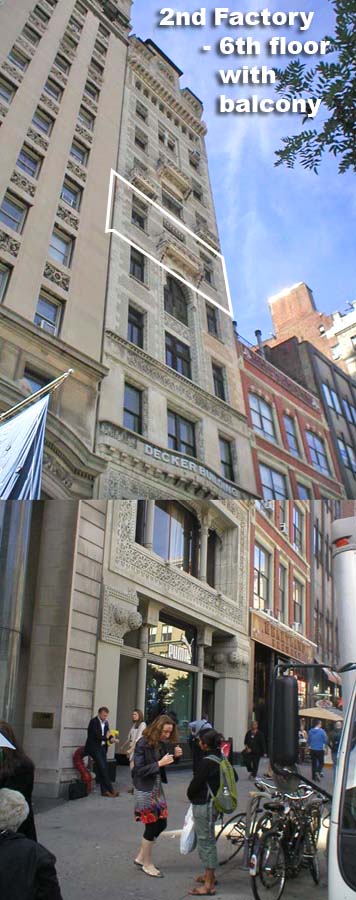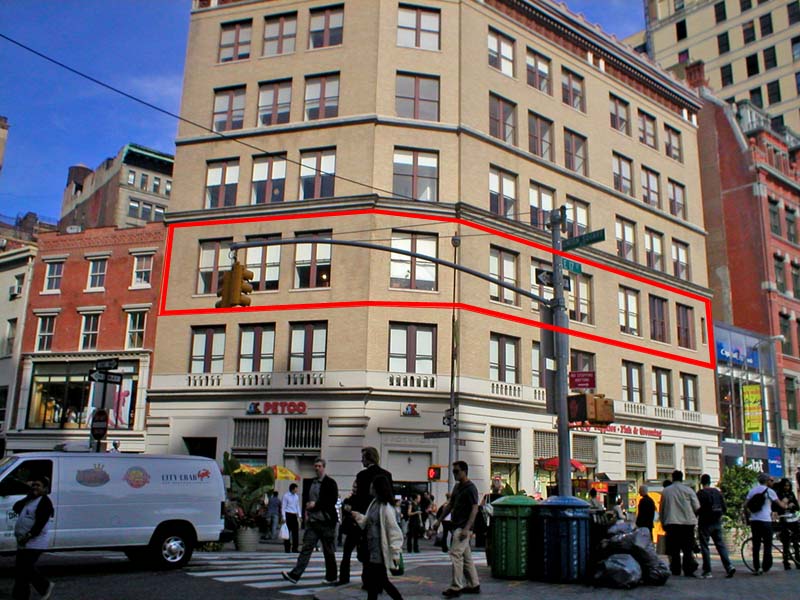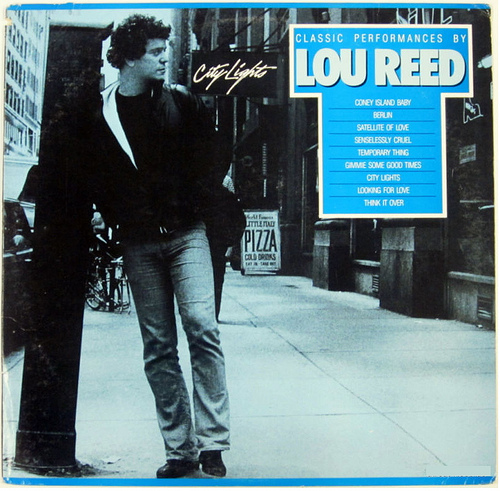 | |||
 | |||

|
Lou Reed - The Velvet Underground Album: THE VELVET UNDERGROUND & NICO, Verve Records, 1967 Photos by Billy Name This is the front cover of the Velvet Underground's first album. It was designed by Andy Warhol. In the original first pressing of the album, under the words "PEEL SLOWLY AND SEE": one could peel off the the bright yellow banana sticker to reveal a pink (almost flesh colored (get it?)) banana inside. A year after the album's release, when it began too take too much time to hand attach the stickers, the sticker was replaced by a photograph. (Later, Warhol would produce a similar cover for Sticky Fingers by the Rolling Stones; containing a 3-d zipper that could be unzipped to reveal a waist-view of man wearing white underpants. 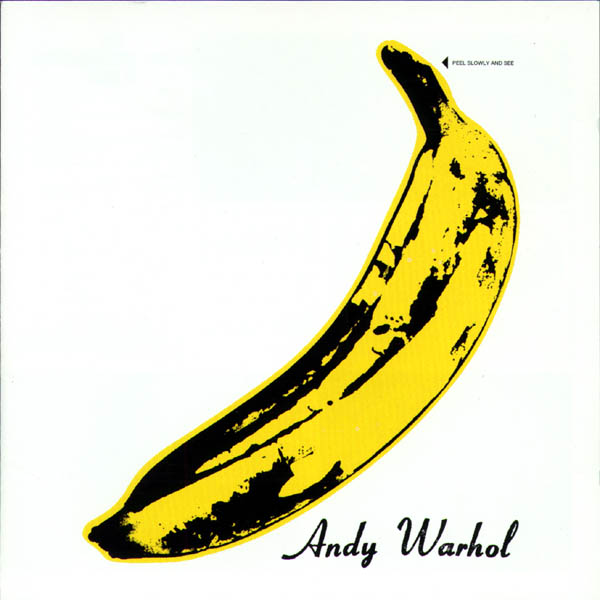
The banana in mid-peel. 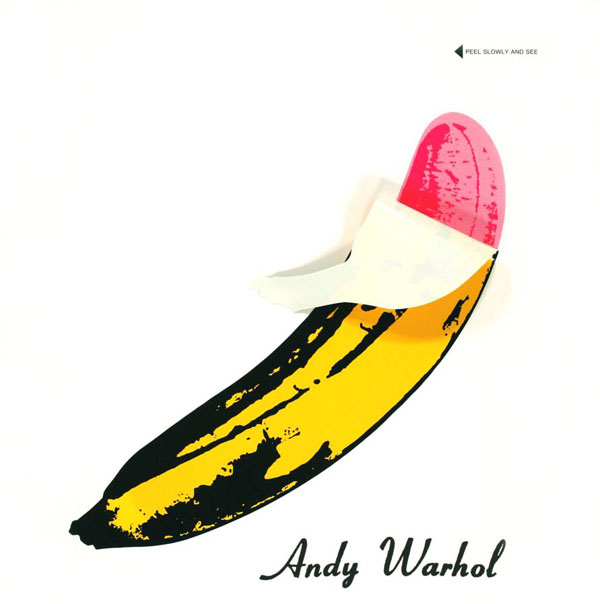
The fully-peeled banana. 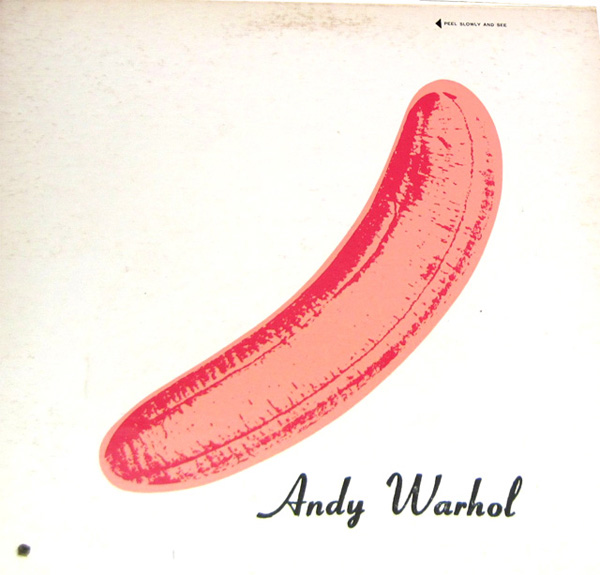
This is a photo of the back cover of "the banana" album. I am not sure of which venue the photo were taken (but check back). 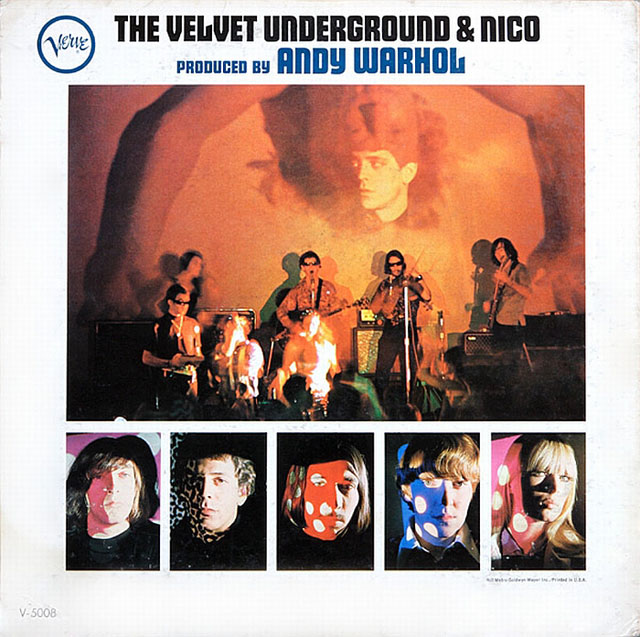
If you look in back of Lou Reed's head there is a larger picture of a man's head. A legal dispute as to the use of the man's image led to the record company covering that part of the picture in later printings of the cover . 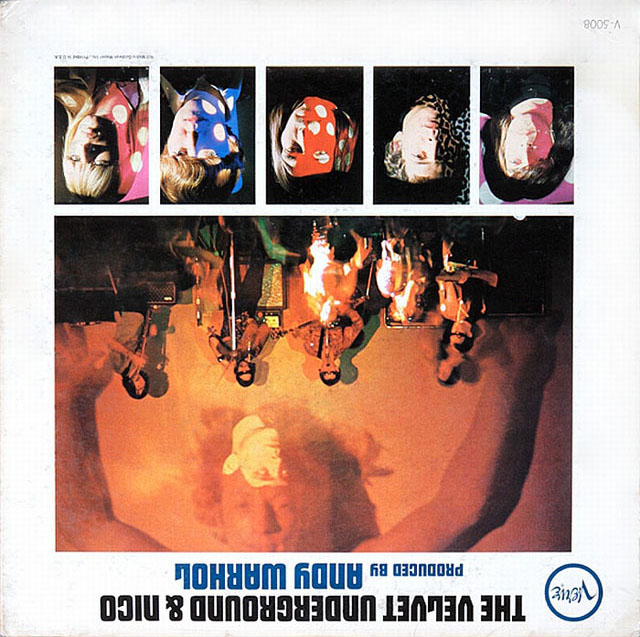
This is s shot of the left inner sleeve of the album. The liner photos are by Nat Finkelstein and Billy Name. (see or purchase their photos at natfinkelstein.com and billyname.com ) 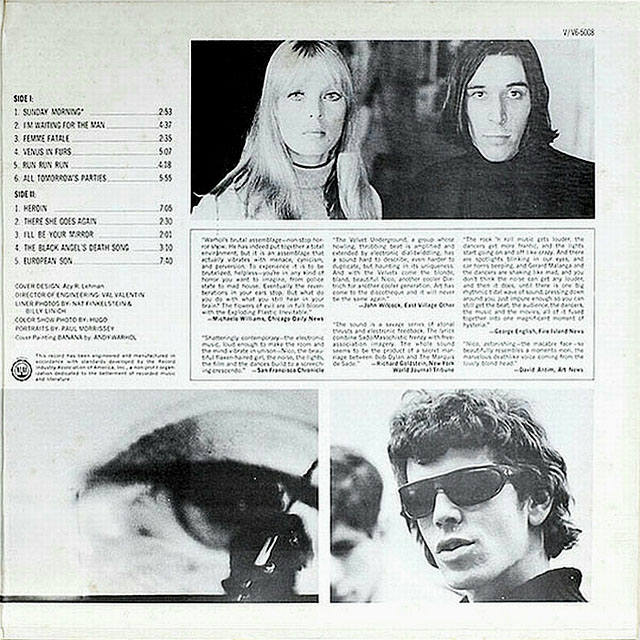
And here is shot of the right inner sleeve of the album. 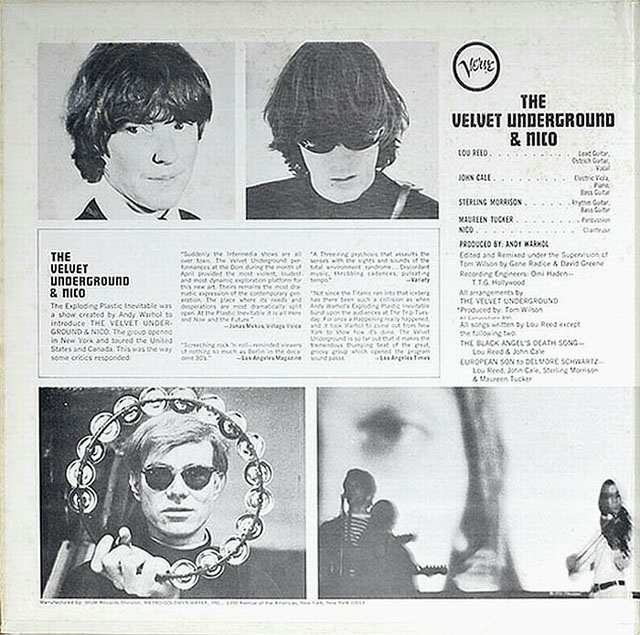
Album Title: White Light, White Heat, Verve Records, 1968 Produced by: Tom Wilson This is the front cover of the Velvet Underground's second album: White Light/White Heat. The cover looks basically black. But... 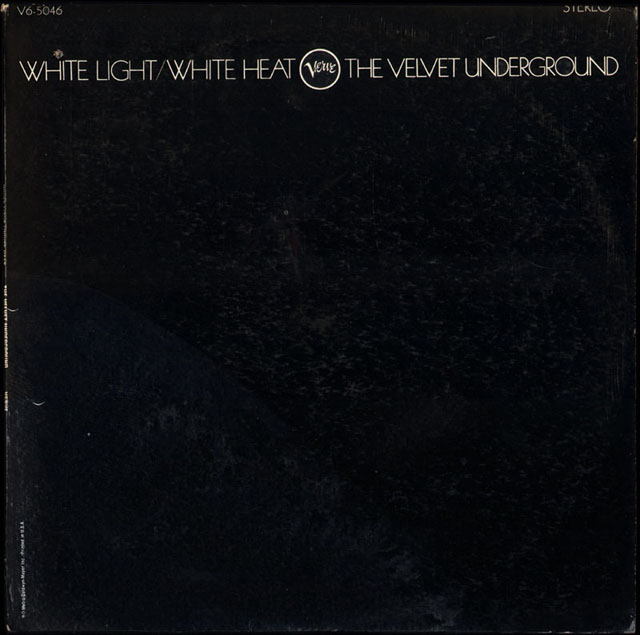
...But if you saw the cover lit at a certain angle, you could see that there was a photo of a pirate-like tattoo printed on the cover in black ink. 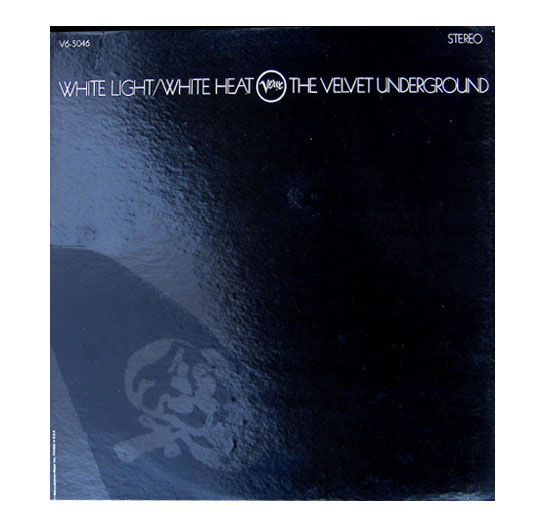
Here's another view of the skull, from an album on Ebay. The skull was photographed by Billy Name, a photographer associated with the Warhol factory. The skull was found on early printings of the album cover. This is the address for Billy Name's website: billyname.com . You can see more of his work and purchase photos there. 
In order for you to see it better I played with the lighting in Photoshop. 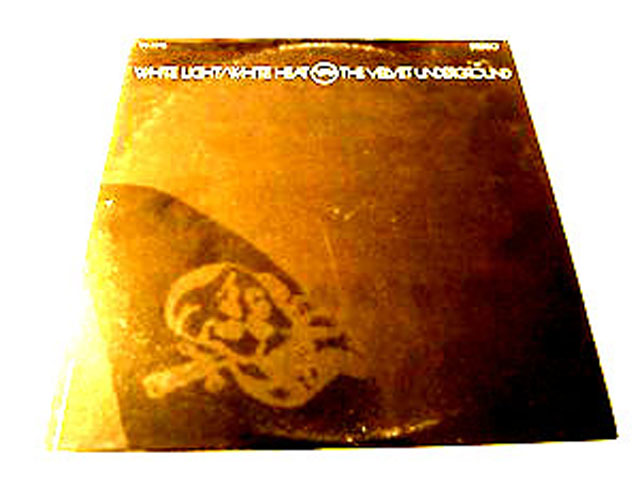
And in this I isolated the skull and straightened it up. You can see a knife blade handle jutting in from the left. I'm not sure if the curved black background is a person's shoulder or not. 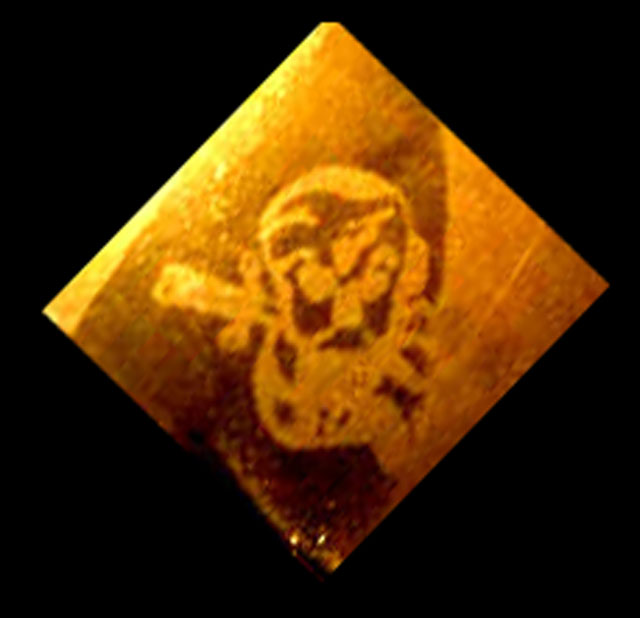
And here, below, is the actual photo. 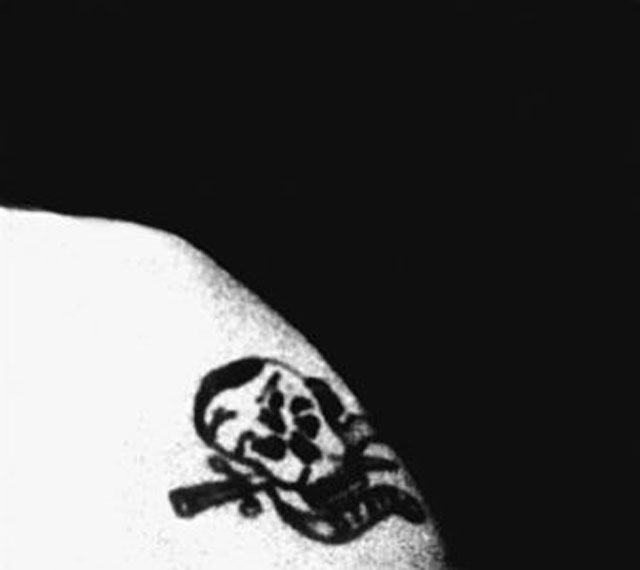
In an email to a Velvet Underground forum writer called Cuckoo, Billy Name wrote "the skull tattoo on the Velvet Underground album cover was from an actor in Andy's "Bike Boy" movie named Joe Spencer." In an interview with Jon Savage (johnsavage.org/journalism/billy-name), Billy says, "The image was a skull and crossbones, from a tattoo that Joe Spencer, one of our actors, had. Lou and I were going through all my contacts to see if there was anything that he wanted to use. He saw this tattoo on Joe's arm in a still and said, "That's what I want on the album," I had to make it a really big enlargement, so it's very grainy. Then we did it on black on the cover." The movie Bike Boy was released in 1967. Here's a still featuring Jon Savage and Ingrid Superstar. I'm pretty sure that's not the cover tattoo. The actual cover tattoo would have been on the back of his other arm. 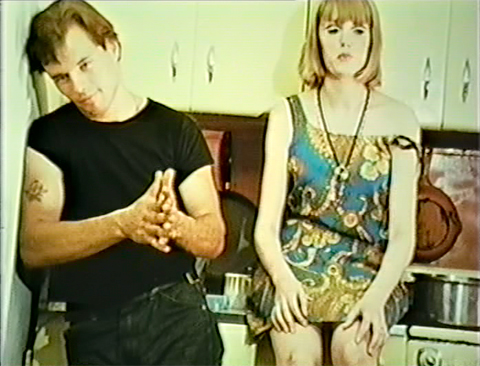
This is the back cover of the album WHITE LIGHT/WHITE HEAT. The band is standing on the front steps of the Boston Tea Party, a 1960's rock club in Boston then located at 53 Berkeley Street. The photo is by Mario Anniballi. At that time the band consisted of Lou Reed, Mauren Tucker, Sterling Morrison and John Cale. You can see the letter "Y" from of the word "Party" over their heads. 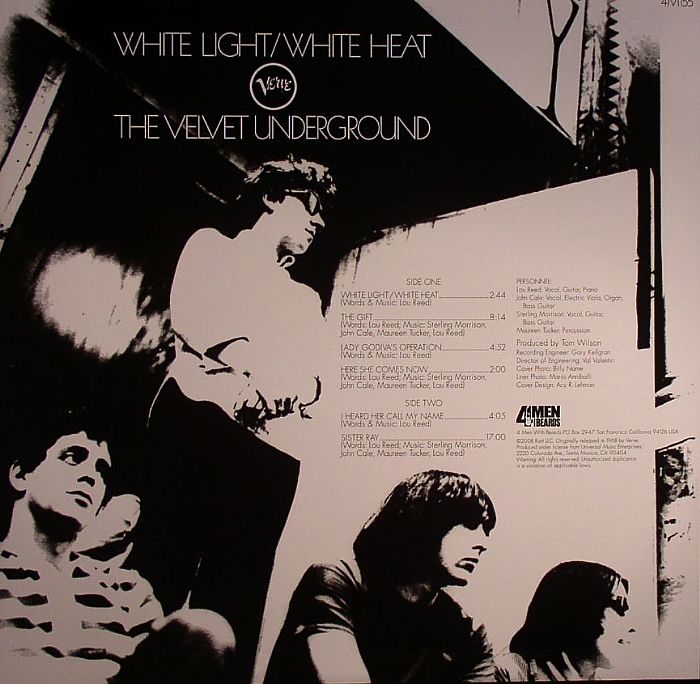
In this version of the photo, from the Velvet's box set booklet, you can see more letters from the word "party." 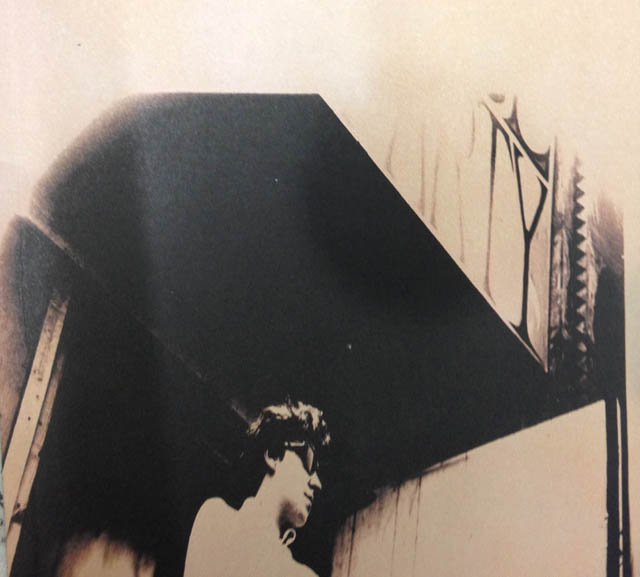
This is a photo of the original Boston Tea Party sign seen over their heads. It comes from website: Jerry's Brokedown Palace which lists where Jerry Garcia and the Grateful Dead played. 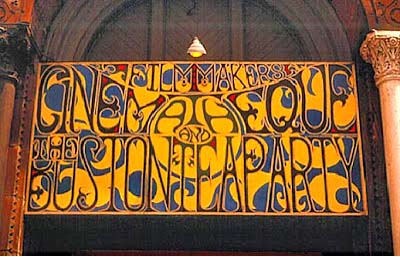
Here's how that sign fits in with the pictures we saw before. 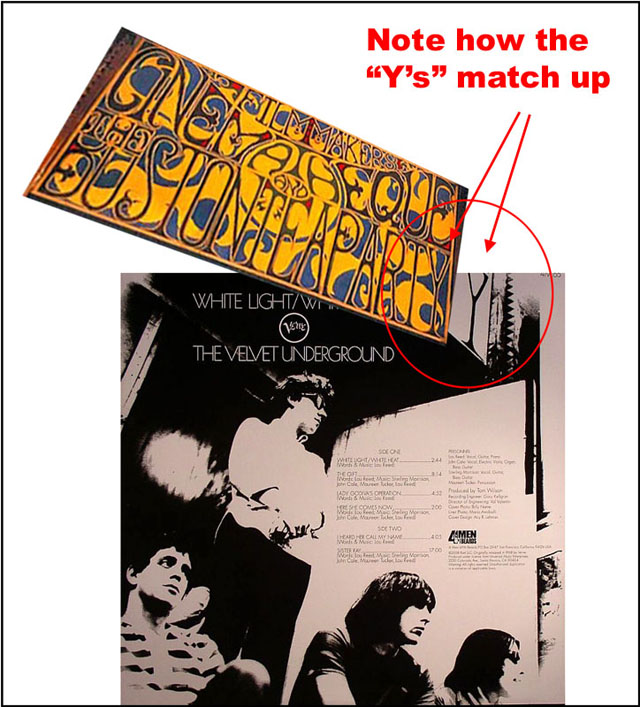
Here's the brick entrance to the former Boston Tea Party club as it can be seen today. 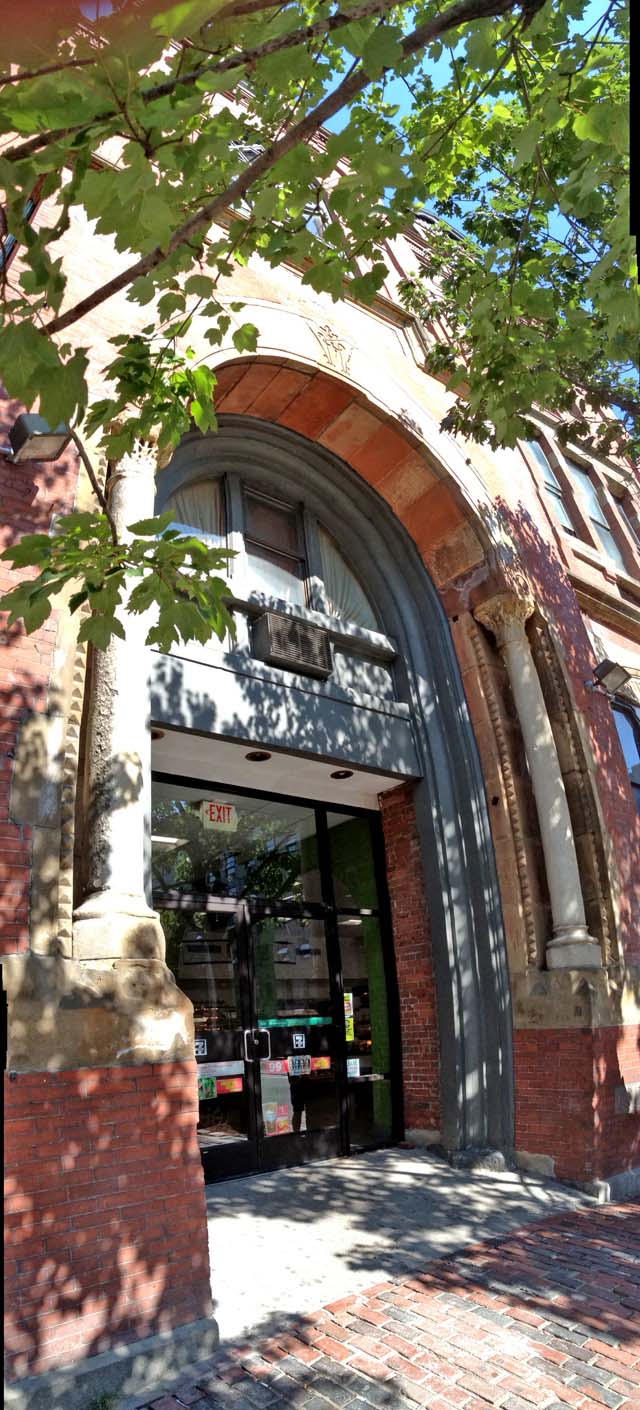
And here it is with the album superimposed. 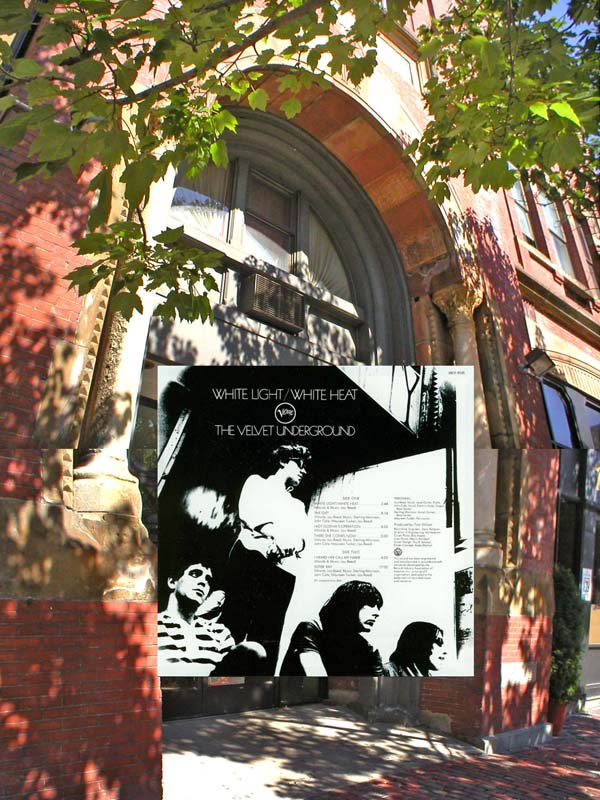
Here's what the whole building looks like. It was once a Masonic Hall. The auditorium was on the second floor. (Thanks to Anne Raso for the tip on this entry.) 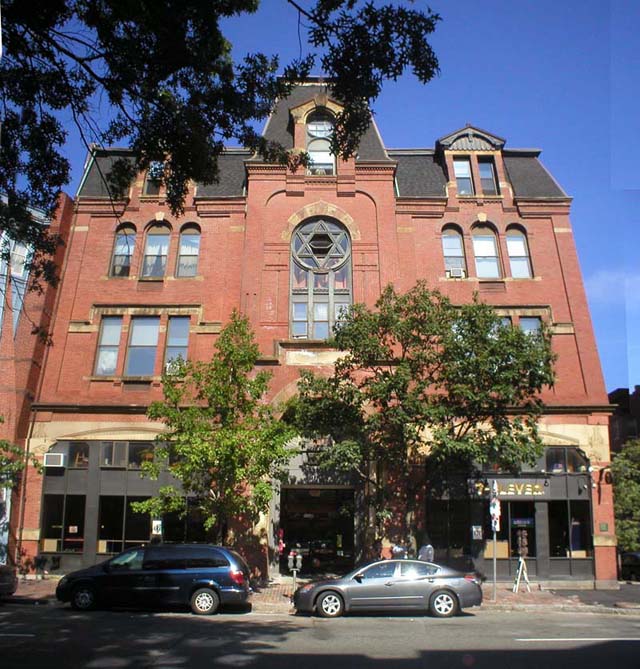
Album Title: The Velvet Underground, MGM Records, 1969 Cover Photo: Billy Name This is a picture of the Velvet Underground's third album entitled simply The Velvet Underground. It was released by MGM in March 1969. The front cover photo was photographed by Billy Name. 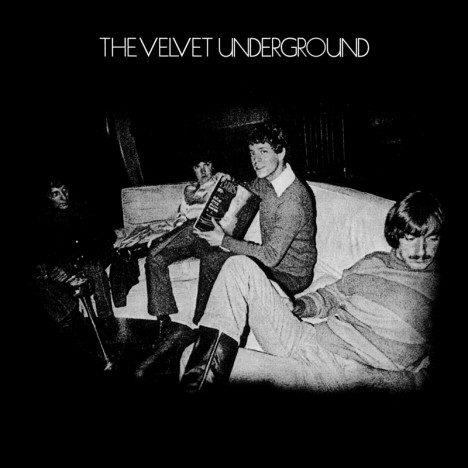
The photo was taken Andy Warhol's "Factory" (i.e. art studio) formerly at 231 East 47th Street (between 3rd and 2nd Aves) in New York. Here you can see the couch on a video. 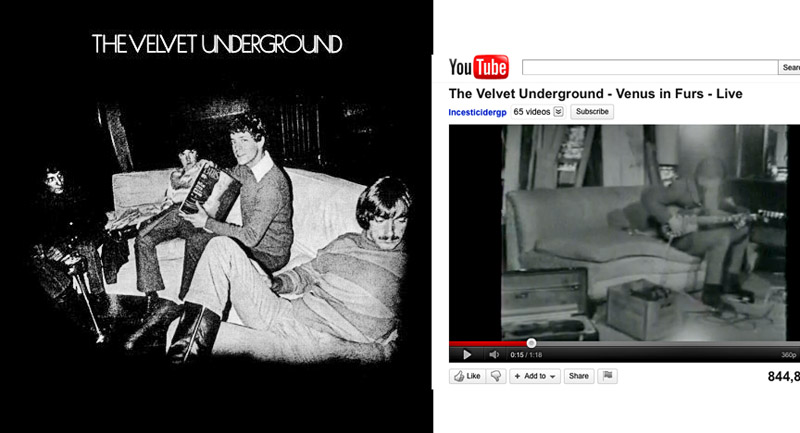
The couch took up a central part of the factory, seen here during a "swingin' sixties party" in a photo by Fred W. McDarrah. 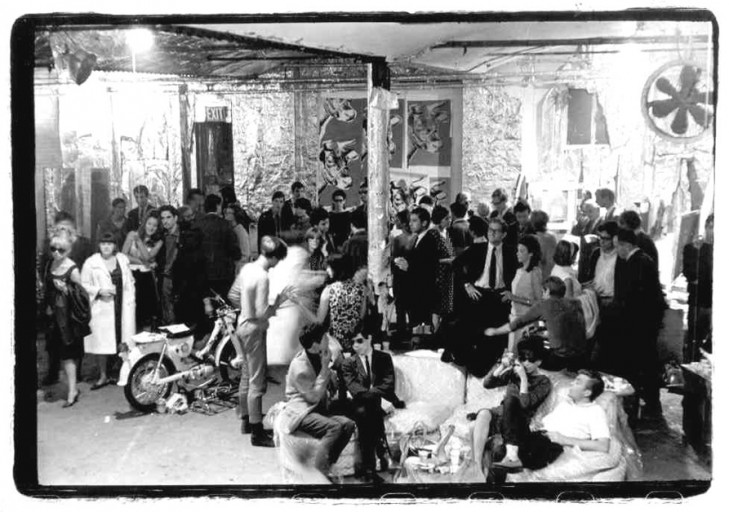
photo by Fred W. McDarrah/Getty Here's the couch and album PopSpotted (though it wasn't taken during the party.). 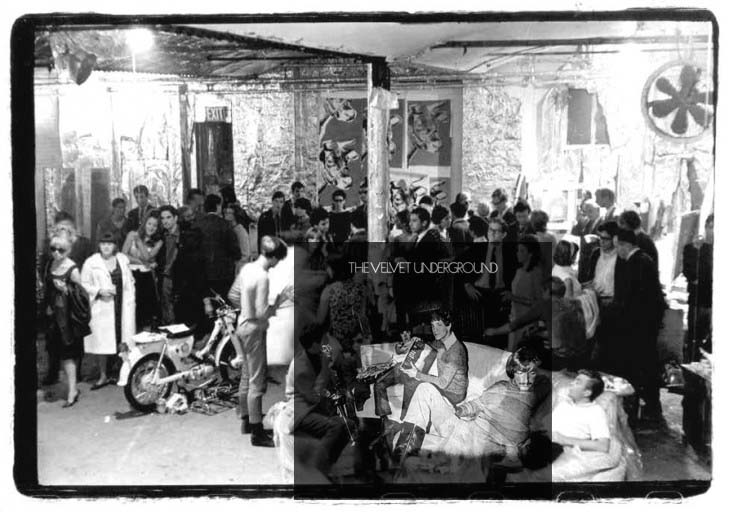
Background photo by Fred W. McDarrah/Getty And here's Lou on the couch from the back of the album. (photo: Billy Name) 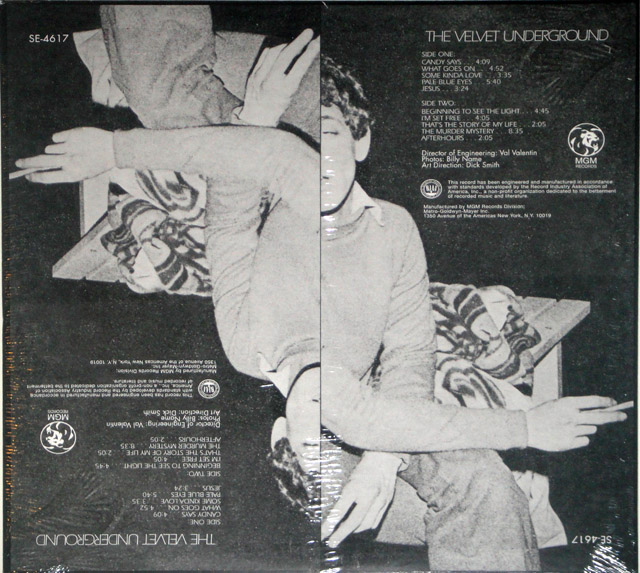
Popspots reader Gavin Roberts from the U.K. sent in this addendum about the cover photo after reading the entry: A cover from a 45-rpm radio-promo from the album features a photo of Lou holding a copy of Harper's Bazaar magazine. In the photo below Gavin has blown it up large in the bottom left corner. 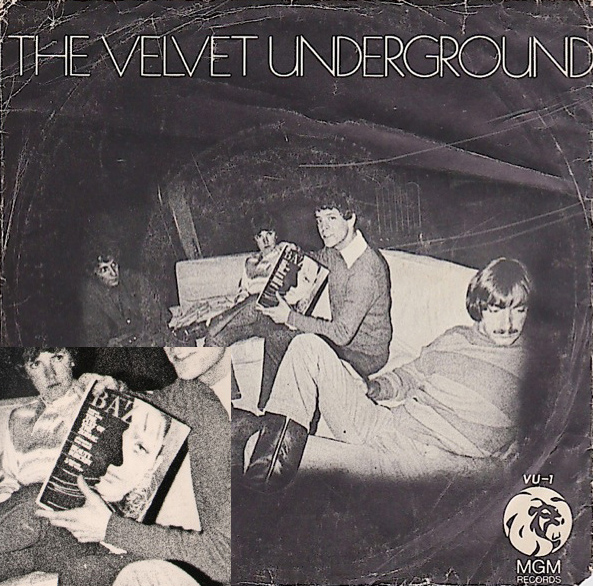
That same photo was eventually used for the LP cover (see excerpt at bottom right), but, so as not to possibly incur usage issues, the Harper's Bazaar cover was completly reconstructed and its title shortened to an illegible word beginning with "B" on the album. (Thank you, Gavin.) 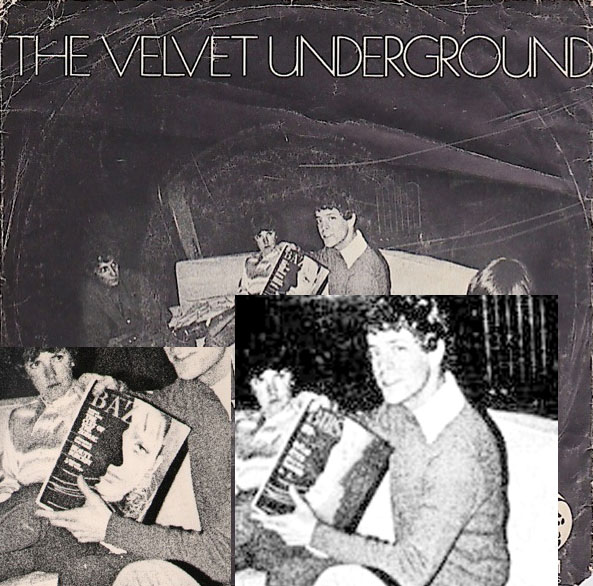
And here, to complete the picture, is a blow-up of the cover in question: Harper's Bazaar, October 1968. (Thank you, P. Tiller.) Gavin also found a color photo out-take of The Velvet Underground cover by Billy Name. (Thank you, Gavin.) 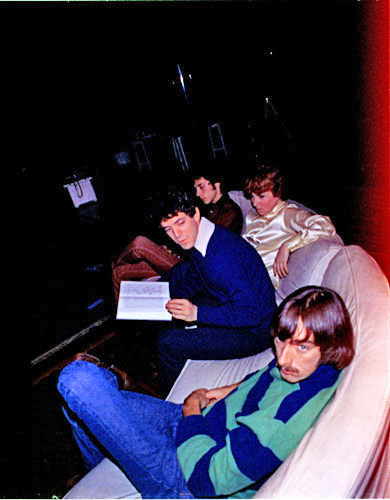
This is a photo of 231 East 47th Street (between 3rd and 2nd Aves) in New York where Andy Warhol had his first "factory" and where the couch photo was taken. It was called the "Silver Factory" because the walls and ceilings were painted silver or covered in silver foil. The building is now demolished and has been replaced by a park at 1 Dag Hammarskjold Plaza. 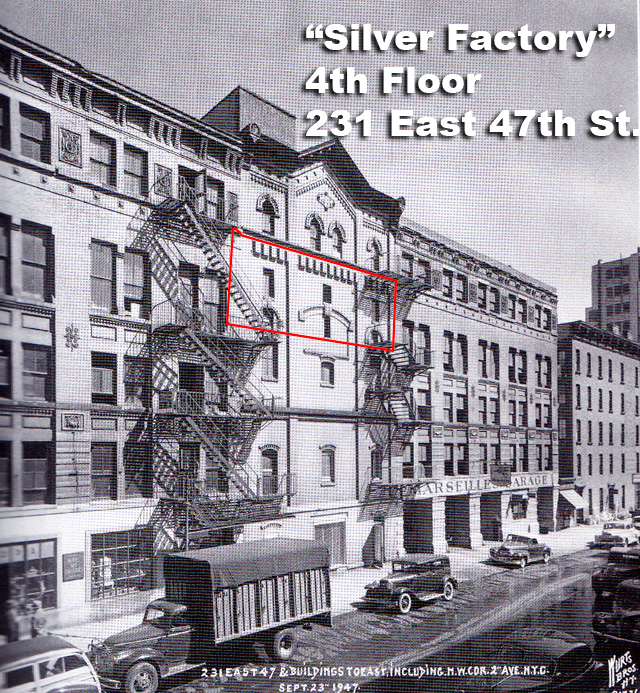
Album: Loaded (Cotillion 1970) Cover illustration and design: Stanislaw Zagerski Here's the cover to Loaded from 1970. I'm still wtrying to find he exact station in Times Square on which it is based. Since the "Times Square-to-Grand Central" Shuttle is listed on the sign, as well as some other subway lines going through Times Square, it has to be one of the 15-or-so subway entrances near Times Square. 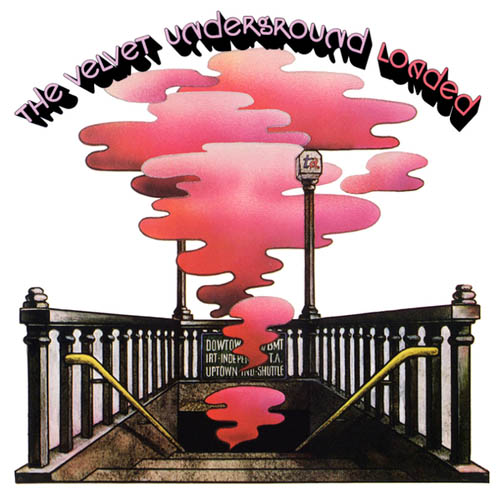
For some reason, the artist left out the first "N" in DOWNTOWN. This subway entrance looks very similar to it and is one of many in Times Square. And speaking of Times Square, this excerpt from Wikipedia gives the address of the recording studio where "The Velvet Underground & Nico" was recorded off Times Square. 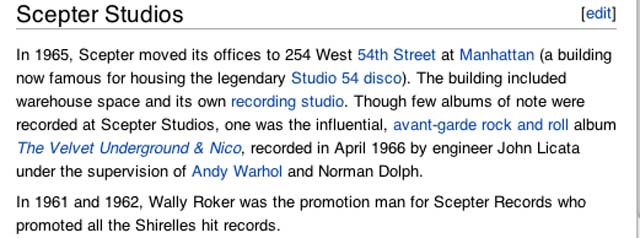
Here's the building today: 254 West 54th where The Velvet Underground and Nico was recorded. It was also where the famous disco "Studio 54" used to be. 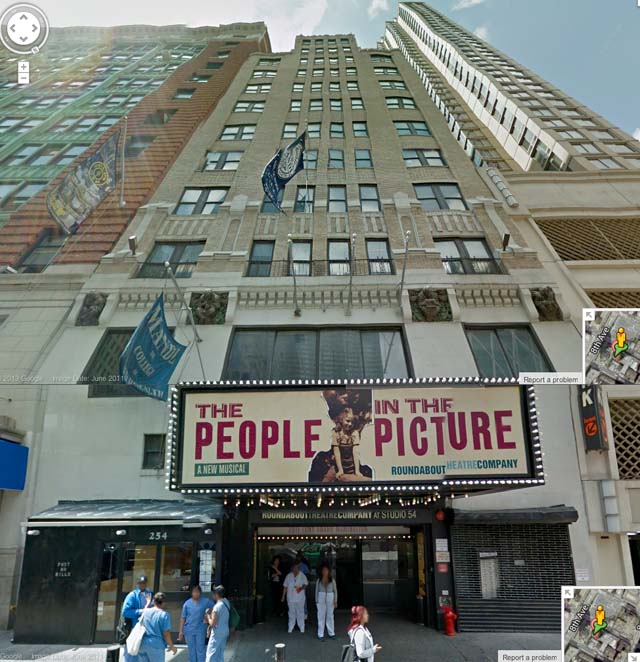
And here's a map of 254 West 54th. 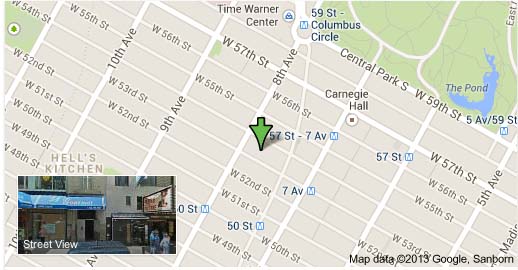
Album - Live at Max's Kansas City - Cotillion - 1972 Recorded by Brigid Polk This is the album cover for The Velvet Underground Live at Max's Kansas City that was released on May 30, 1972 by Cotillion, a subsidiary of Atlantic. It was recorded by an associate of Andy Warhol's named Brigid Polk on a portable cassette recorder on August 23, 1970, the last concert Lou Reed Played with the Velvet Underground (Wikipedia) The cover photo of Max's Kansas City was taken at Park Avenue South between 17th and 18th Street on the east side by Fred Lombardi. 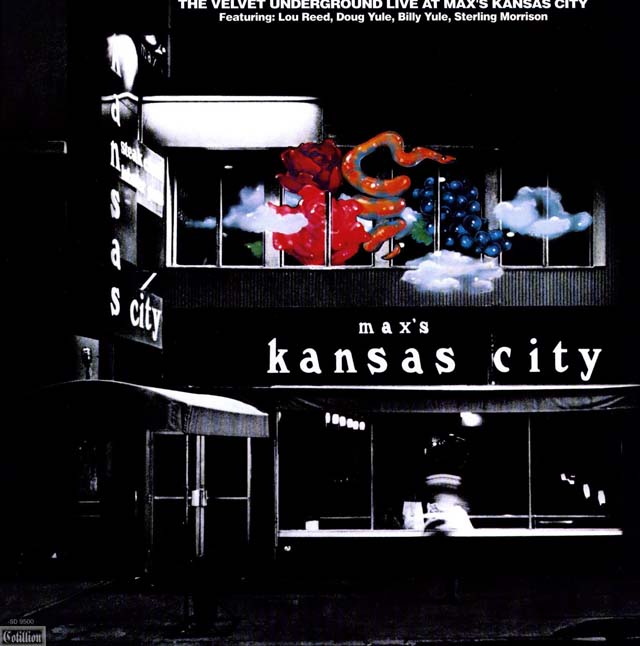
This shows where Max's was, in the middle of the block on the east side of Park Avenue South between 17th and 18th Street. The space was recently a deli. 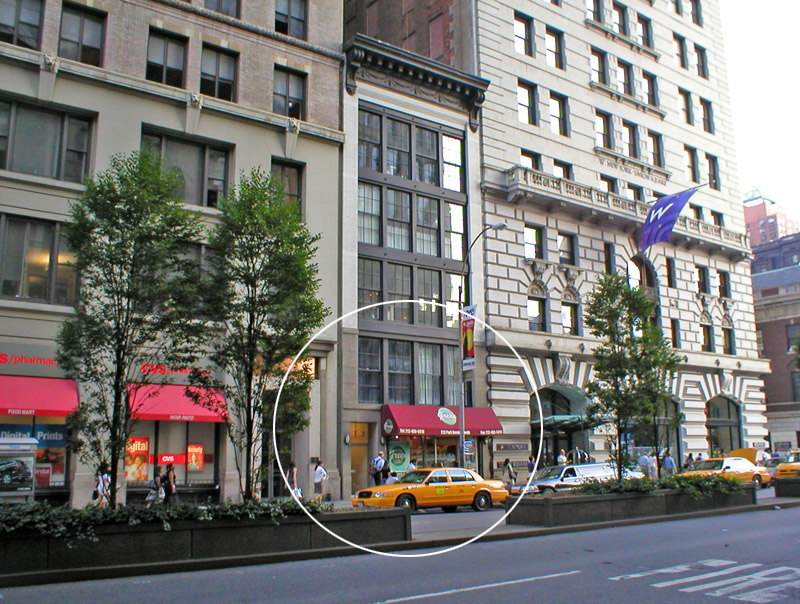
Here's what he space looked like during renovations in 2012. 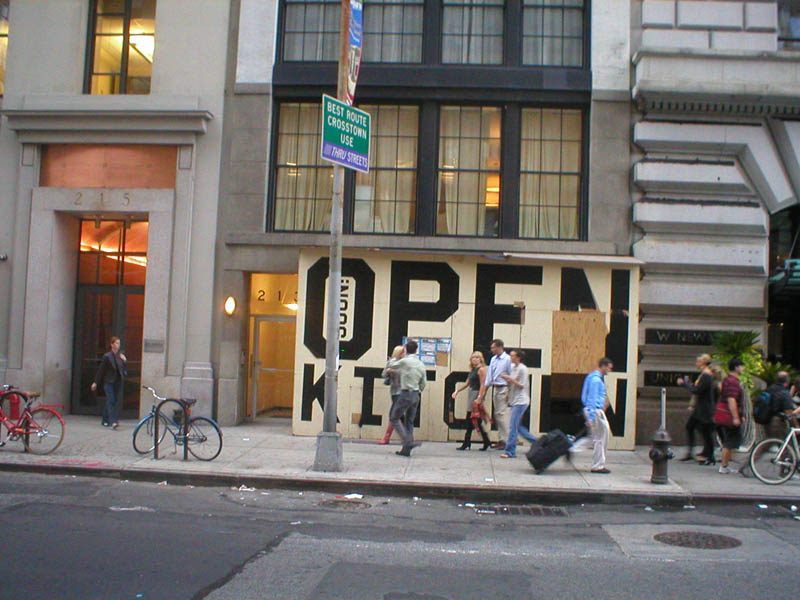
...and PopSpotted. 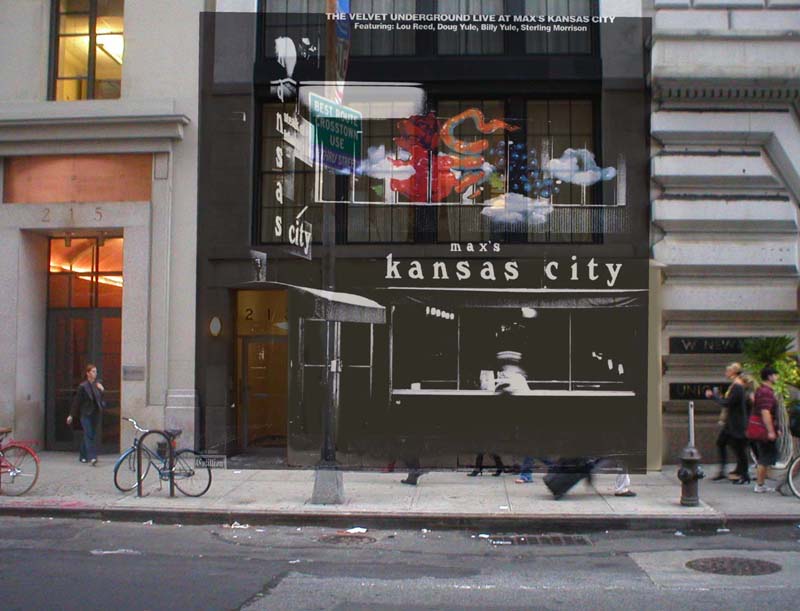
...and mocked up from another angle. 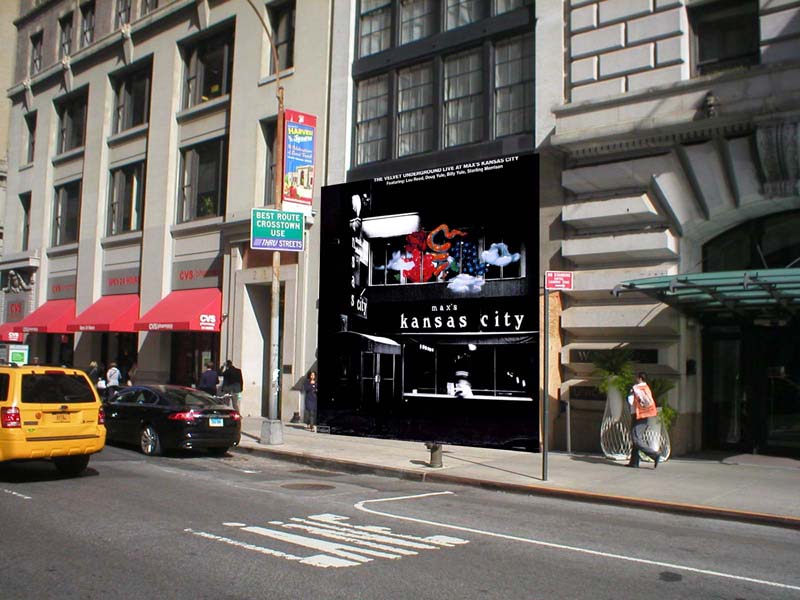
This is the back cover of Live at Max's Kansas City. 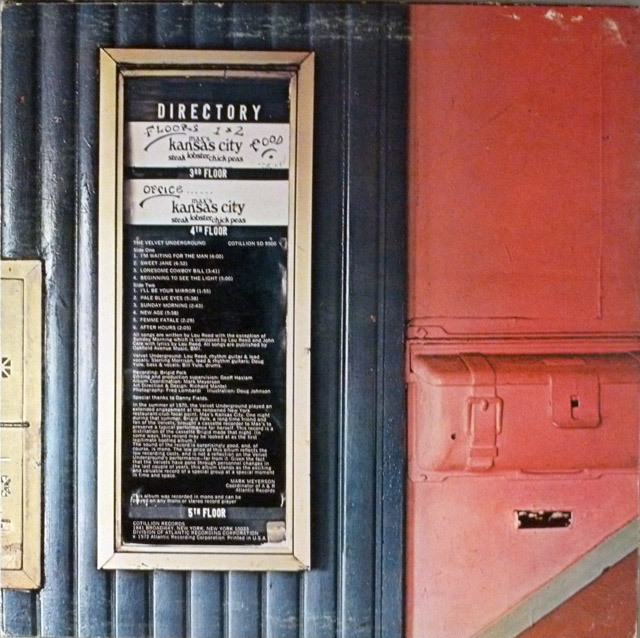
Max's was a longtime hangout of Warhol and his crowd, as it was was right around the corner from Andy Warhol's second and third "factories" along Union Square, just north of Greenwich Village. This was the second Warhol "factory" (1968-1973). It was located on the 6th floor of the Moorish-style Decker Building located at 33 Union Square West between 16th and 17th Street.
And this was the third Warhol "factory" (1974--1984). It was located on the 3rd floor of 860 Broadway at the northeast corner of Broadway and 17th Street. For many years one could see the back of one of Andy's white wigs in the window on a fake head.
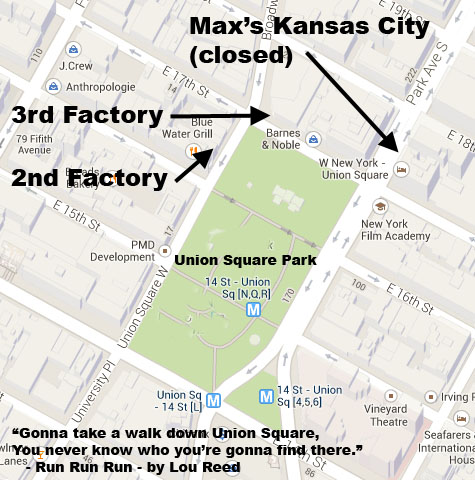
This is a composite photo of the front of 56 Ludlow Street in the Lower East Side. John Cale and Sterling Morrison lived on the top floor of the 5-story walk-up. 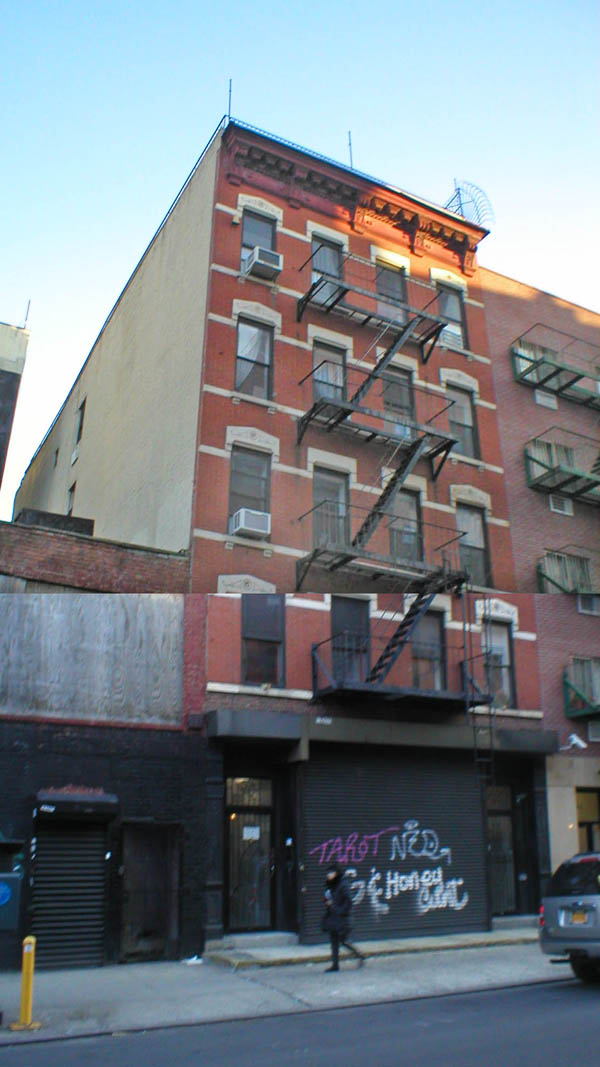
This is 56 Ludlow at night (I forget who's in the doorway of the shot, but that's the doorway the Velvets would have entered.) 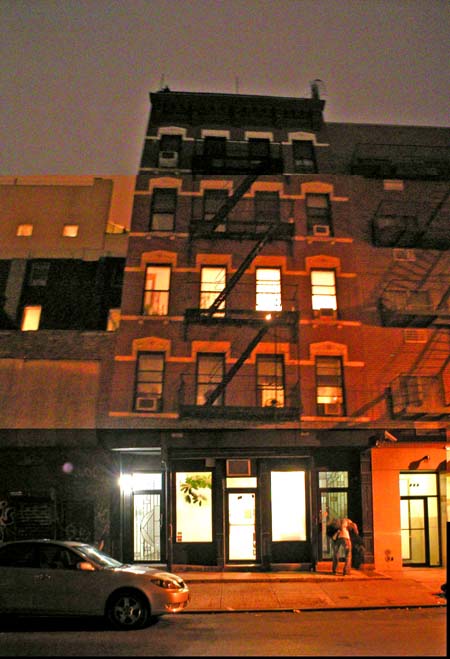
And here's a close-up of that doorway with an artistic "56" in the grating. 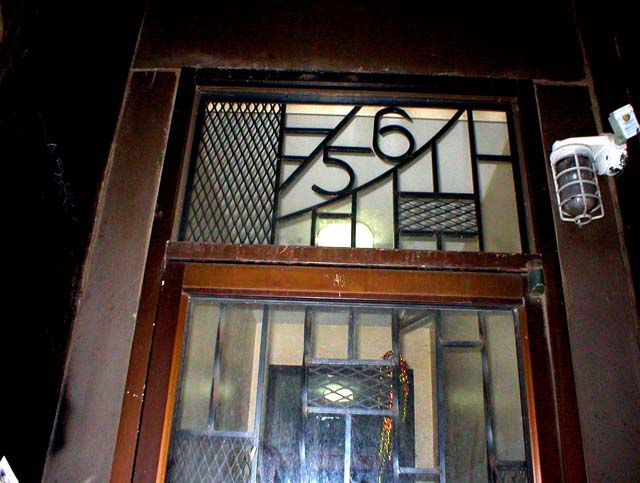
This is a panorama of Ludlow Street and 56 Ludlow looking south from Grand Street. Back from the turn of the century until the 1930's this neighborhood in the Lower East Side was swamped with poor immigrants packed into these tenements. In the 50's and 60's artists and musicians came to these sometimes rough neighborhoods for the low rents. 
Here's a 1965 shot of the early version of the band at 52 Ludlow Street, a few doors south of 56 Ludlow where John Cale and Sterling Morirson lived and where some early versions of Velvet Underground songs were first recorded. (The members are, from left, John Cale, Angus MacLise, Sterling Morrison, and Lou Reed.) The photo is by Donald Greenhaus. (To see/buy photos by Donald Greenhaus go to shabobba.com) 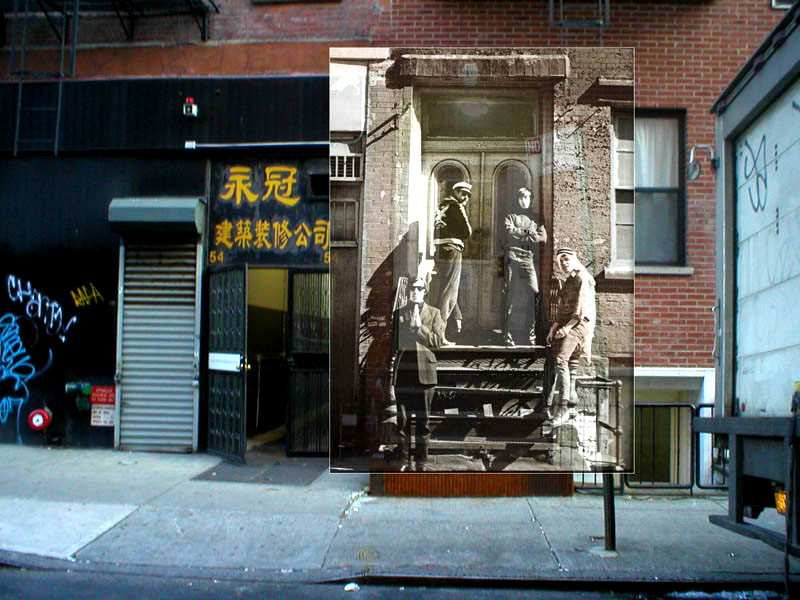
Here's the door by itself. Here's how I go on location to match up the spots, usually after finding them on Google Street views. 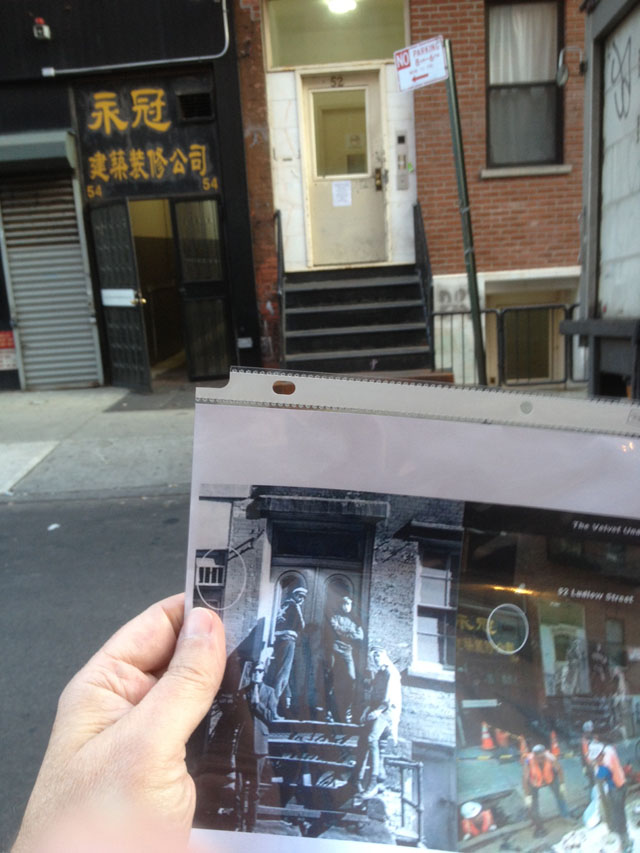
From that same day's photoshoot by Donald Greenhaus, here's a shot from the roof of 56 Ludlow Street in the Lower East Side of Manhattan looking east. 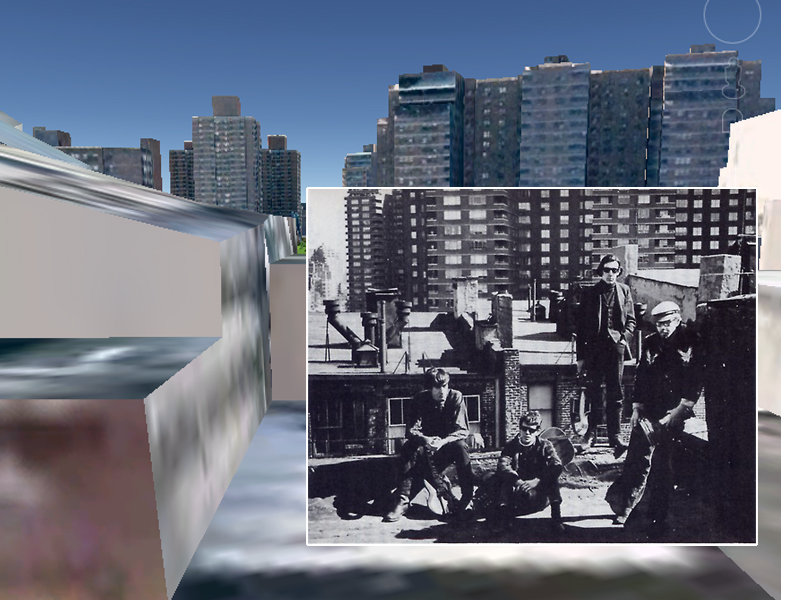
These are the buildings in the background. 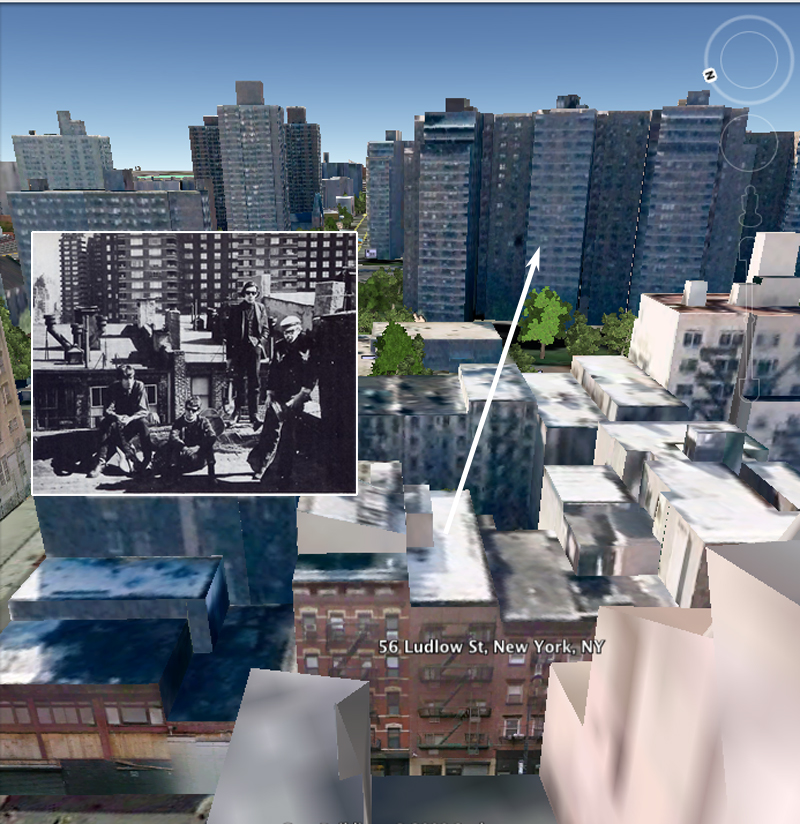
Also, from the Donald Greenhaus photoshoot, the band was photographed about 2 blocks away in an area called "Five Forks" where 5 streets come together. (I did this search after a website called Flaming Pablum challenged its readers to find the site.) 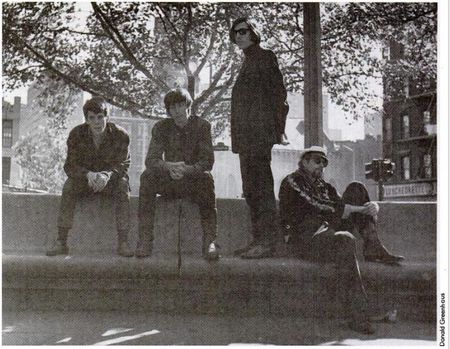
Here's the long, curved concrete bench on which the band was sitting. 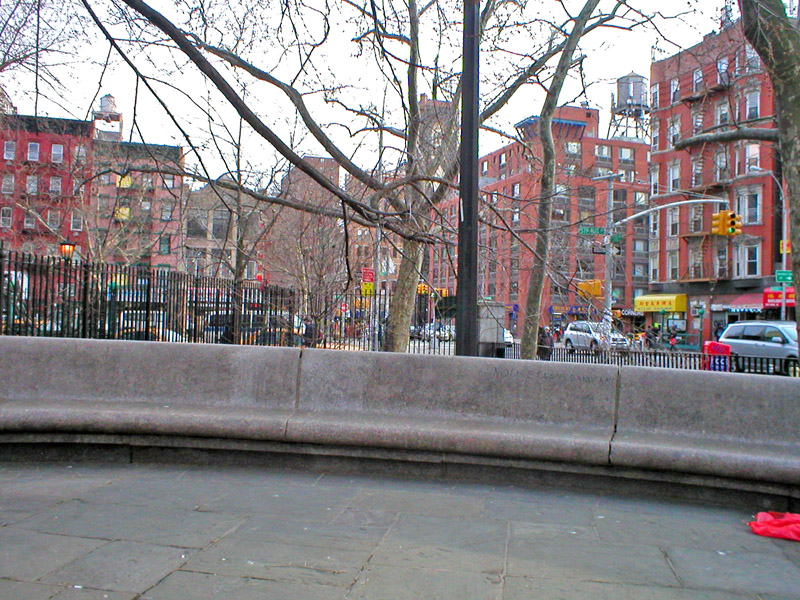
The PopSpot of the scene. 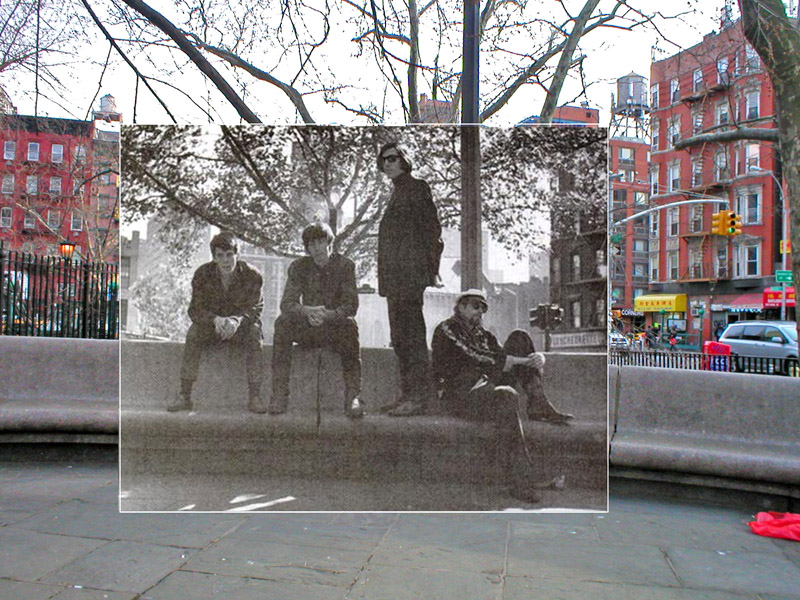
Another view of the area, with the bench at left. The tall building on the back, The Forward Building, left was for many years the offices of The Jewish Daily Forward - a very popular and influential Jewish newspaper in the first fifty years of this century. 
Map where the above photos were taken. 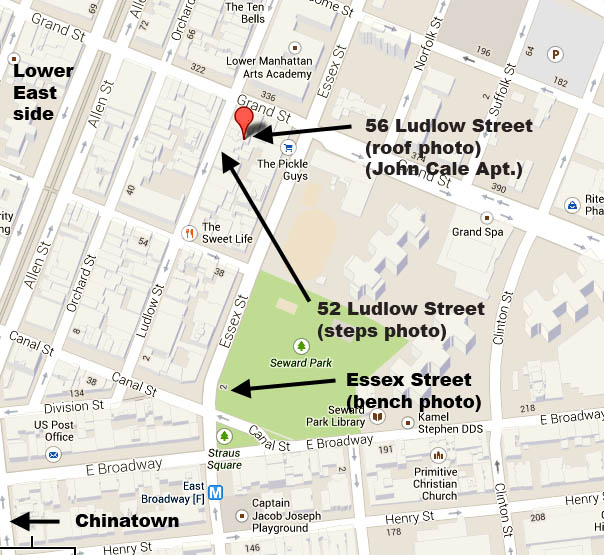
This is a cover of a compilation Velvet Underground CD. It features an outtake from a famous series of Velvet Underground pictures which included Andy Warhol, taken by Warhol "Factory" photographer Gerard Malanga in Los Angeles California. (To see/buy photos by Gerard Malanga, please go his website at gerardmalanga.com) 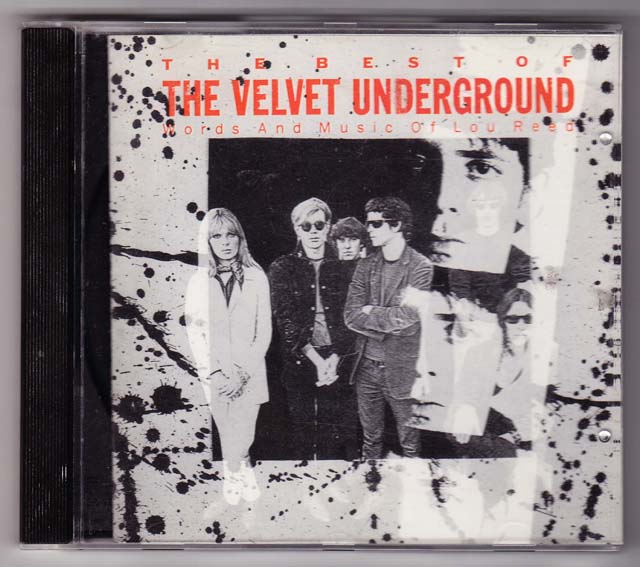
Here's another book featuring an outake from the same session. 
The photos were taken in May 1966 behind a mansion called "The Castle," (pictured below) located at 4320 Cedarhurst Circle in the Los Felix neighborhood of Los Angeles. Film star Norma Talmadge had lived in the mansion when it was known as "The Cedars. Later Arthur Lee of the rock group Love lived here. In the mid-sixties rock groups could rent the mansion out for $500 a week while visiting L.A. 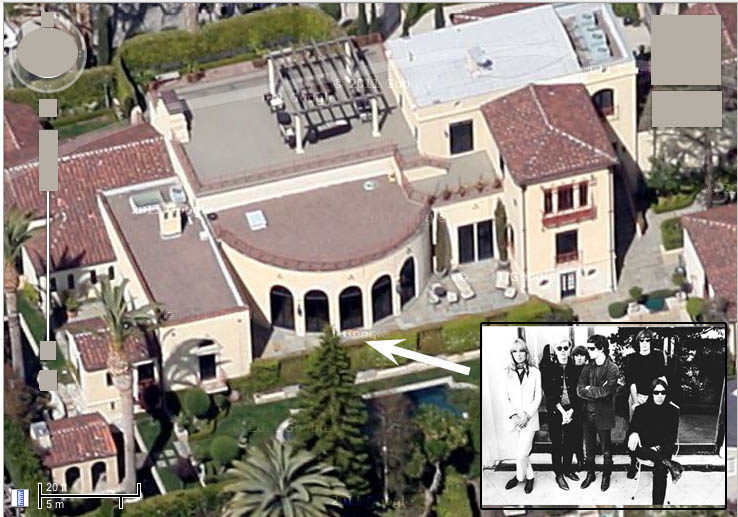
Here's where the building is in location to the City of Los Angeles. 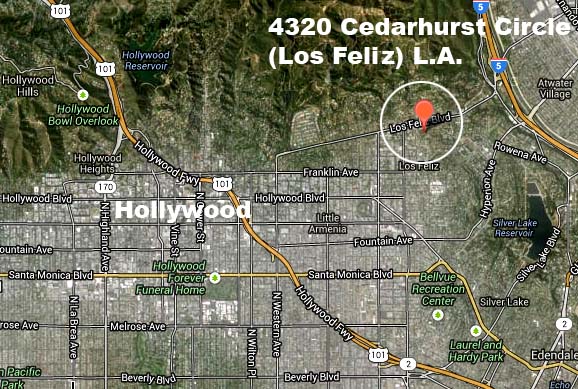
And here's a close-up of the book photo in front of the large picture window in the back of the house where the group was standing looking out over Los Angeles. 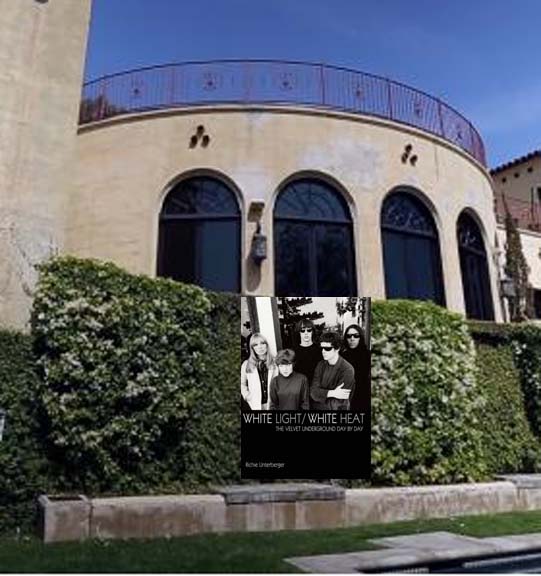
This is the cover of Lou's 1972 solo debut album, released by RCA records 2 years after he left the Velvet Underground. The view is a look up Park Avenue in New York. The illustration was painted by Tom Adams. 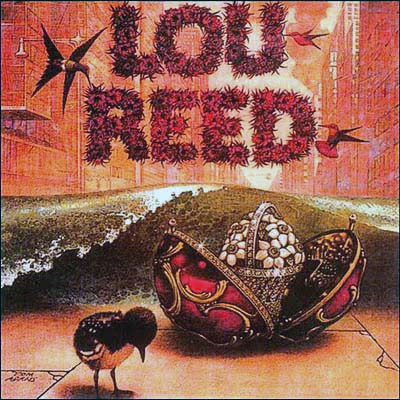
One can tell the exact location by matching up the horizontal and vertical "glass box" slabs part of the famous Lever Building on the left. 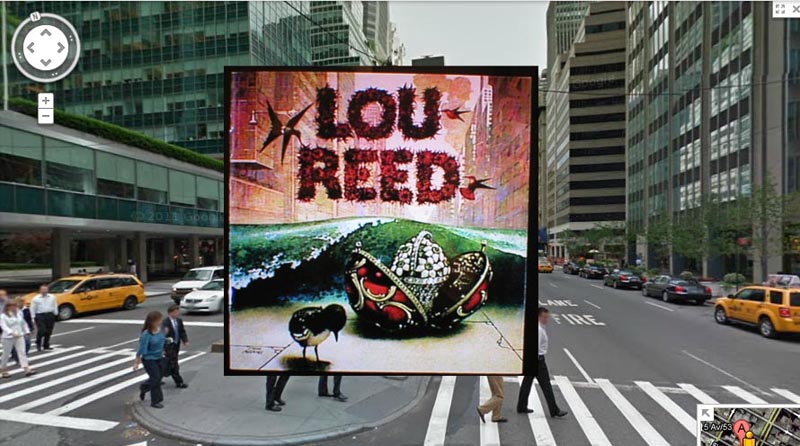
Here's the scene without the album. Lever House is located at 390 Park Avenue between 53rd street and 54th Street on the west side of the Avenue. 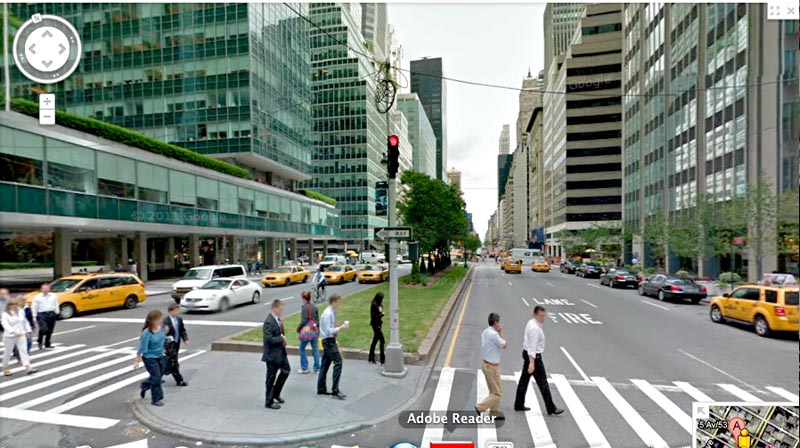
The largest part of the illustration is a Fabergé egg, jewelled toy-like eggs, which keep opening to revel more eggs, made by the jeweler Fabergé for, most famously, the Tsars of Russia as Easter gifts for their wives and mothers. Here's one on view at the Metropolitan Museum of Art in Manhattan. 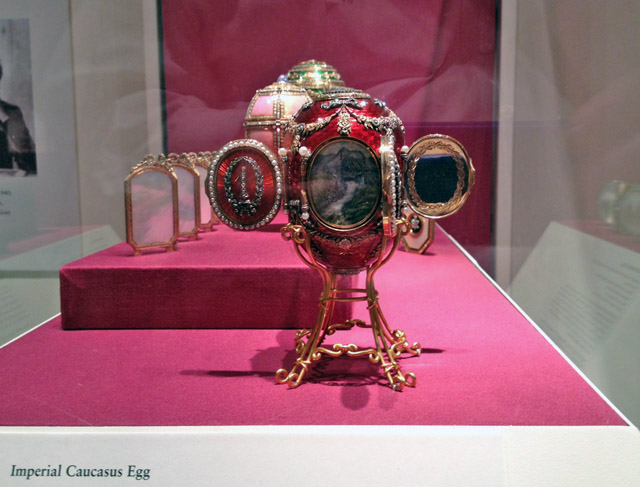
(After this entry went up, Marie Fotini, chief European PopSpots correspondent, sent in this picture of the Faberge egg upon with the cover is most likely based. It's called The Spring Flowers egg. A more detailed description can found below the picture. Neither Marie nor I know how the Fabege egg, or the kiwi or hummingbirds, or the floral patter of Lou's name tie in with the album content. A future mystery to solve.) 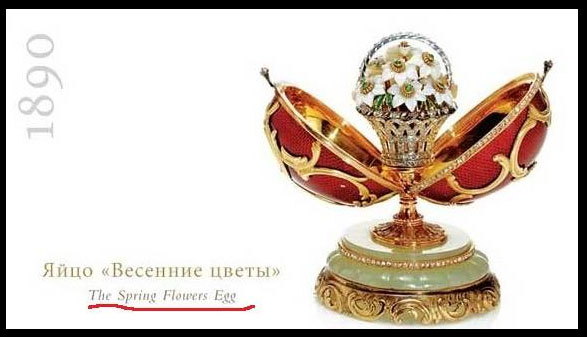

The Lou Reed compilation album below came out in 1985 from Arista. the cover photo is by Dave Gahr. (For more information about David Gahr's photos see DavidGahr.com)
There are two signs in back of Lou. One says" City Lights" which turns out to be the title of the album, not a store name. The other sign said "Little Italy Pizza." That's the clue that led me, via a 1985 phone book, to West 46th and Sixth Avenue where a Little Italy Pizza outlet once was. 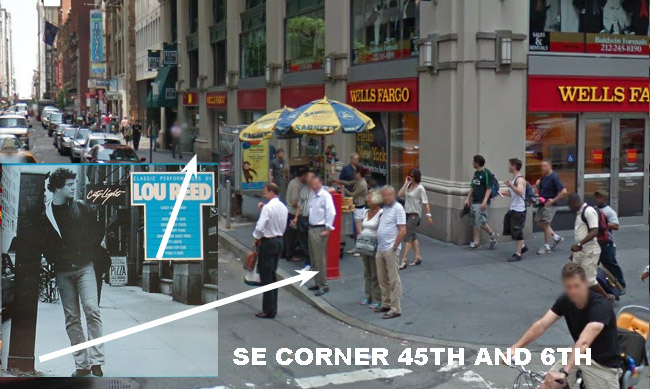
Without the people around, here's the old fire alarm (still there) that Lou was leaning on. A 12" section of the alarm is missing off the top. 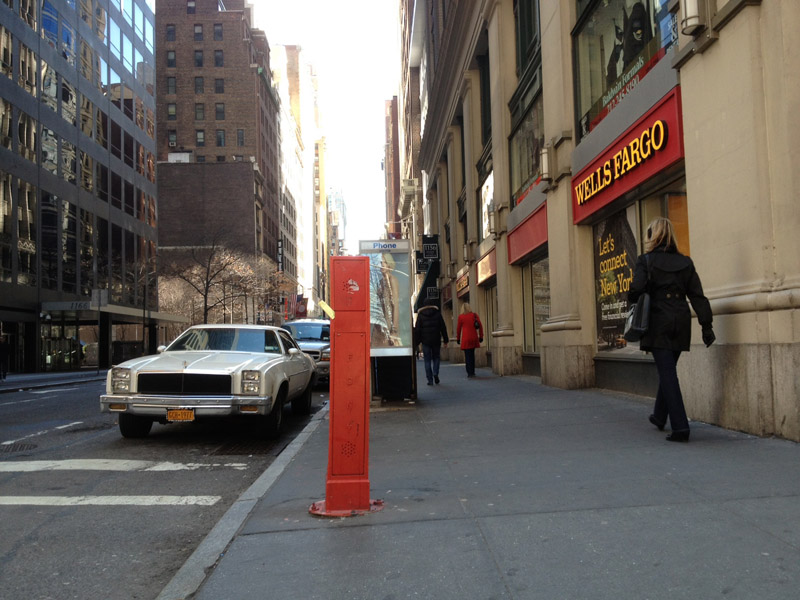
And here's the PopSpot. 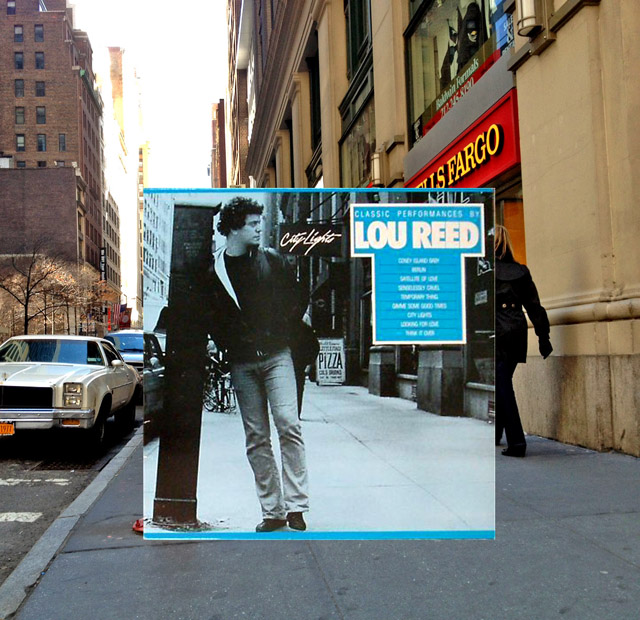
Right after that shot, Lou hails a cab uptown. The scene is 46th Street looking up 6th Avenue (aka Avenue of the Americas.) Again, photographed by Dave Gahr. 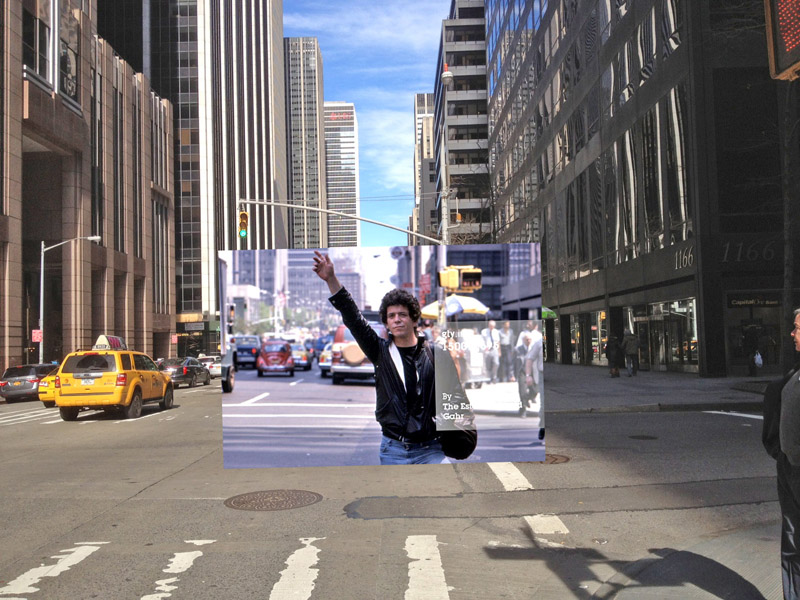
Following the albums below is a shot of the rock club where in 1973 where Lou recorded Rock and Roll Animal (released in 1974 by RCA) and its companion volume Lou Reed Live (released in 1975 by RCA). 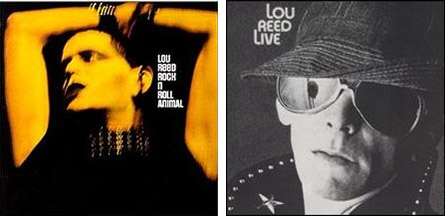
The venue at that time was called Howard Stein's Academy of Music. It later changed its name in 1985 to The Palladium. It's now demolished and an NYU dorm called "The Palladium" is in its pace. 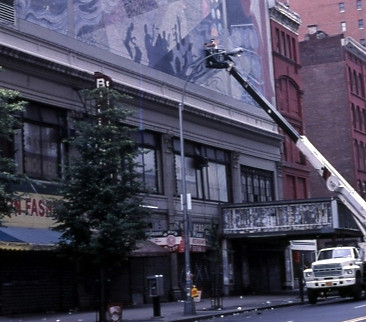
This next image was an advertisement for White Light/White Heat that is found in many compilations about the Velvets. It shows them in a field of grass. The photo is taken from such a steep angle that there are no clues to its location in the background. It always intrigued me because I associate the Velvet's with urban scenes not pastoral scenes.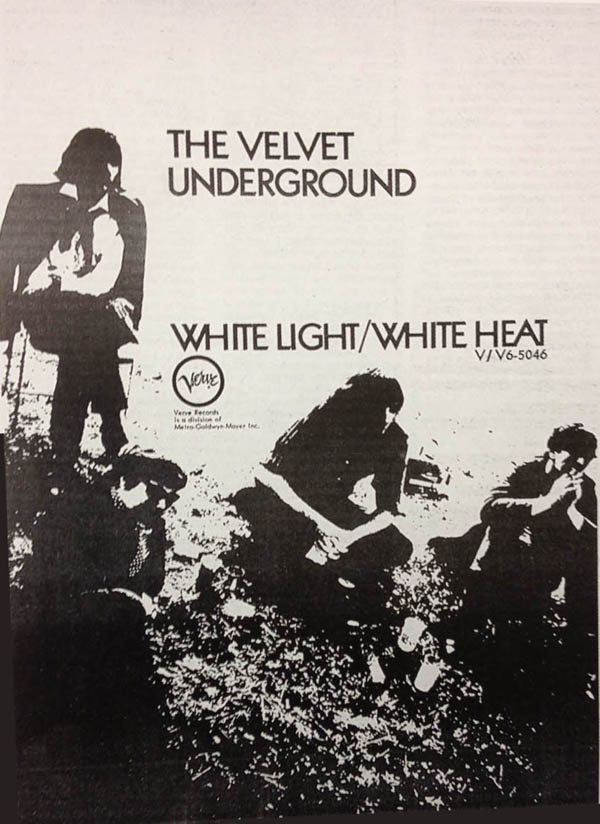
It's usually produced in high contrast so you can't see the faces of the group, but there is a version from the Velvet underground Box Set booklet in which you can make out their faces. 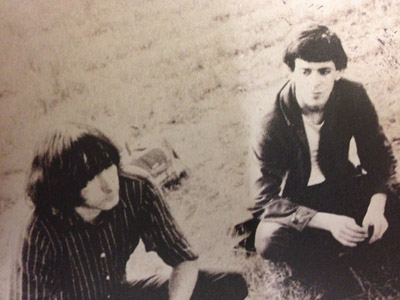
(Here's a better version sent in by PopSpots reader Gavin Roberts after the entry was published. Thank you, Gavin.) 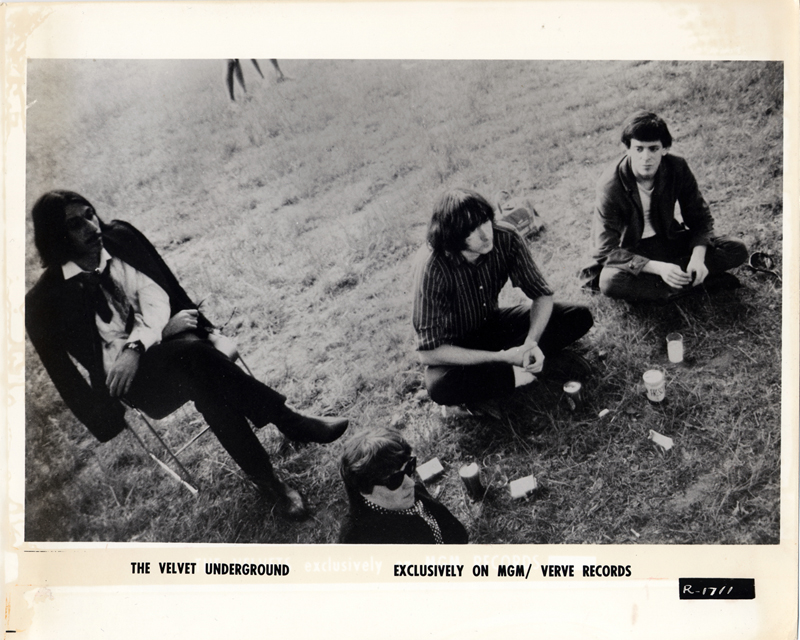
I ended out finding where it was shot in this book that I've had for 30 years. The book is Up-Tight: The Velvet Underground Story by Victor Bockris (who also wrote the Lou Reed bio called Transformer) and Gerard Malanga, one of the major photographers of the Warhol scene. (See Amazon.com for books about Lou Reed, Andy Warhol, and others by Victor Bockris. See itAmazon also for Gerard Malanga books or go to gerardmalanga.com) 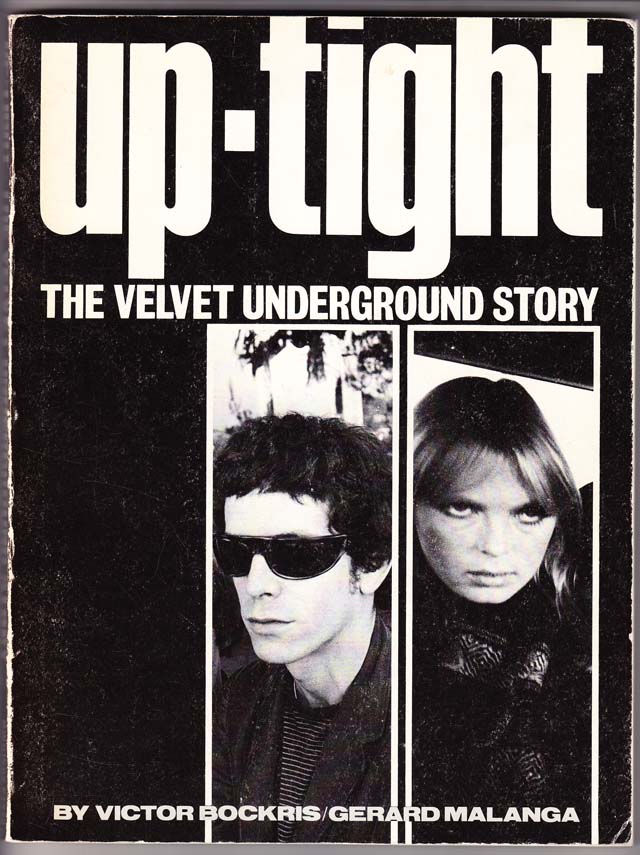
In it, there are three small photos by Steven Shore, taken in the exact location. (Steve Shore has been a photographer for over 40 years. His many books include The Velvet Years, Andy Warhol's Factory, 1965-1967 To see more of his work, see his website at: stephenshore.net ) 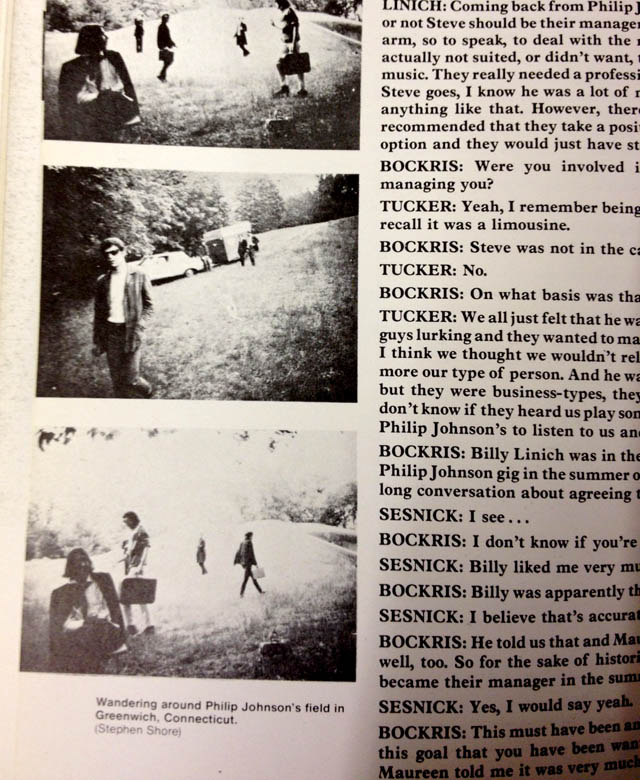
It turns out that the photos were taken at a country " happening" (a 60's art-type party) which took place on August 1967 on the grounds of the noted architect Philip Johnson's famous Glass House in New Caanan, Connecticut to benefit the Merce Cunningham Dance Company. 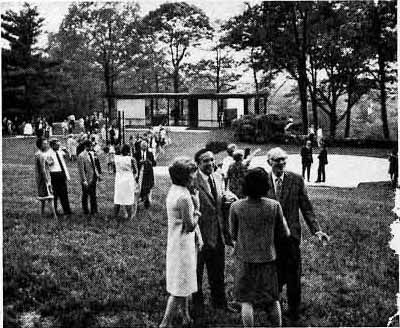
Merce Cunningham dancers performed on a large wooden platform to the music of abstract-musician John Cage. Then The Velvet Underground played while the assembled Connecticut/New York patricians danced the frug and watusi. I think the Velvet Underground ate in the foreground in this photo playing to the dancers. 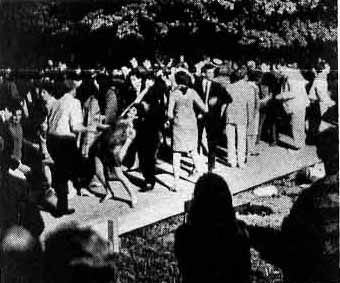
Based on the severe drop off of the land in the back of the photo, I think that the photo for the Velvet Underground ad was taken in an open space behind the glass house near a small pond. To find this space on Google or Bing maps, search for "Ponus Ridge Road and Arrowhead Trail, New Canaan" 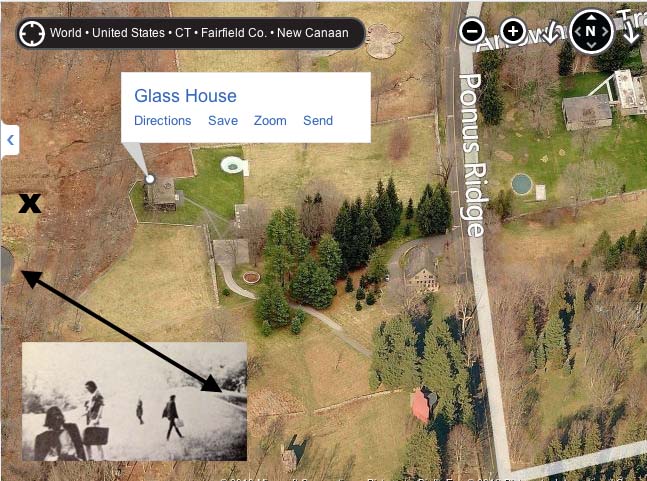
You can actually see the Glass House on Google Street Views. To get there, search for "Ponus Ridge Road and Arrowhead Trail, New Canaan"; then drag the little Google man to the road just south of the intersection, which gets you to Street View. Then spin the man around till you see the house. 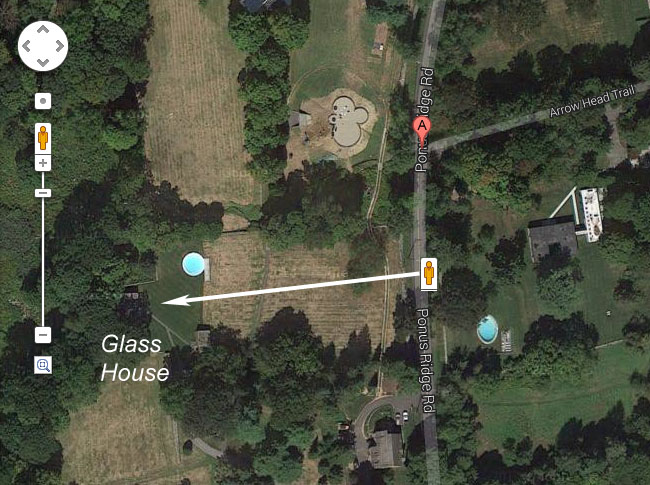
Here's what it look like. You can zoom in. 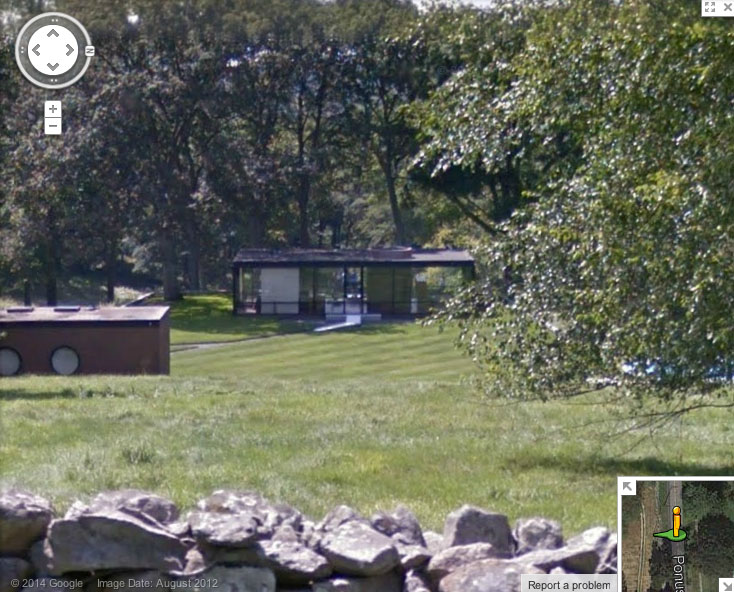
And finally, here's a copy of the book from which "The Velvet Underground" took its name. Tony Conrad, a filmmaker and friend of the band, who lived across the hall from John Cale on Ludlow Street, found a copy of the paperback in the street and showed it to the group. The fact that it conveyed the idea of "underground" culture along with it's fitting the s/m theme of Lou's early song "Venus in Furs" ("Shiny, shiny, shiny boots of leather") made the name fit the group's aesthetic and began the group's legendary walk on the wild side. 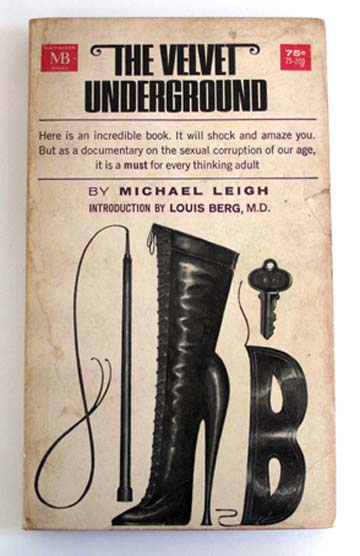
So that was the end of the original PopSpots entry. AND THEN - FOLLOWING THE ADDENDUM - YOU WILL BE ABLE TO CLICK TO: - 450 Grand Street 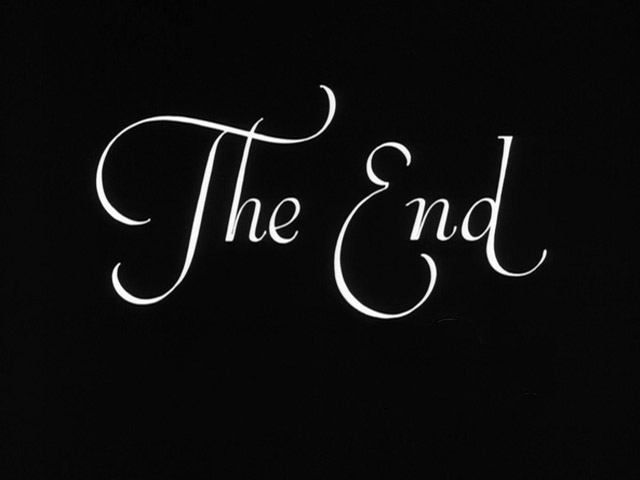
ADDENDUM This is a picture of Lou Reed and his college band at Syracuse University in 1964. It is a photo from the 1964 College yearbook called the The Onondagan. They are playing on the front porch of the Sigma Alpha Mu fraternity, then located at 712 Comstock Avenue. The building has been replaced by a large dorm. 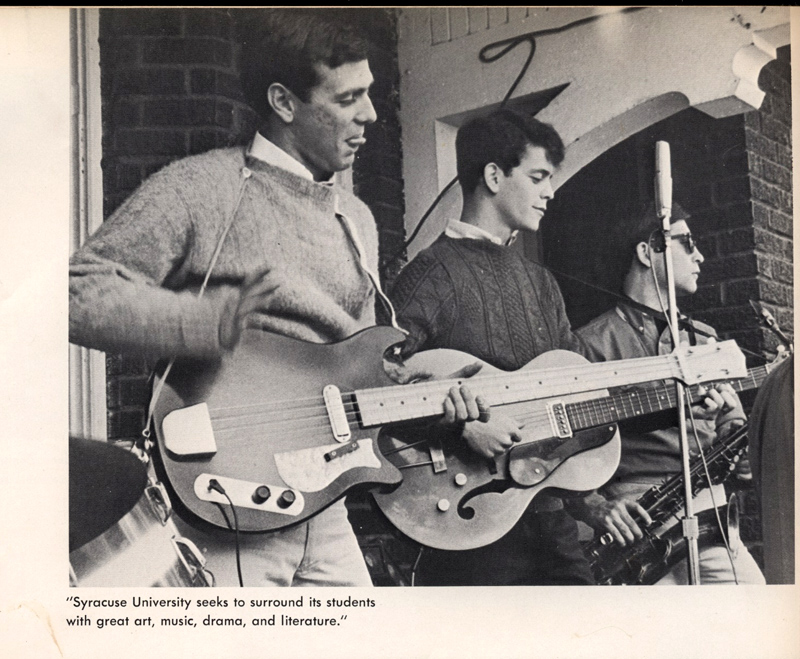
Here's a picture of the Sigma Alpha Mu fraternity house from the 1962 Syracuse yearbook. 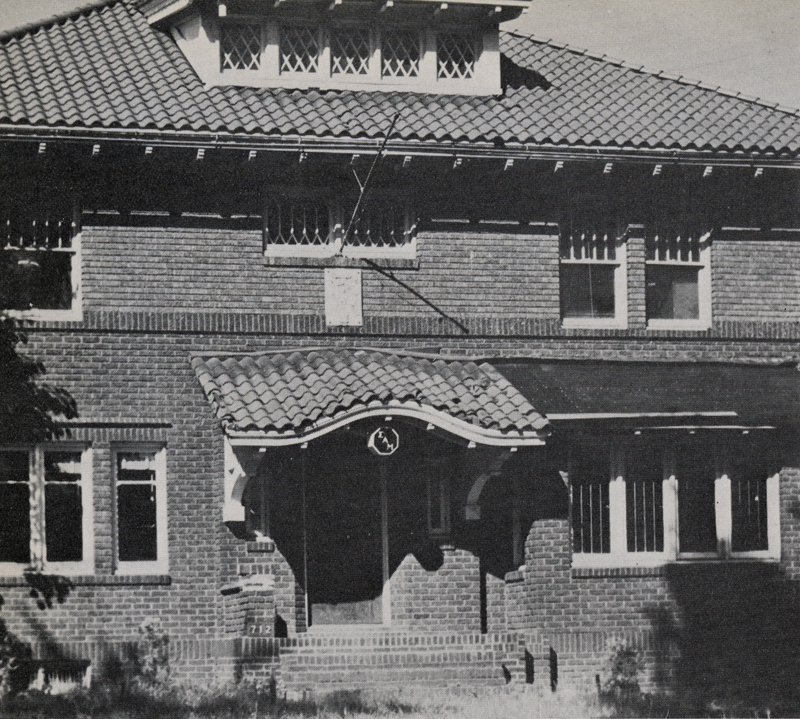
In this PopSpot, I've taken the 1964 photo of the band and superimposed it on it's exact location on the 1962 yearbook picture. (You can click the photo to enlarge it.) 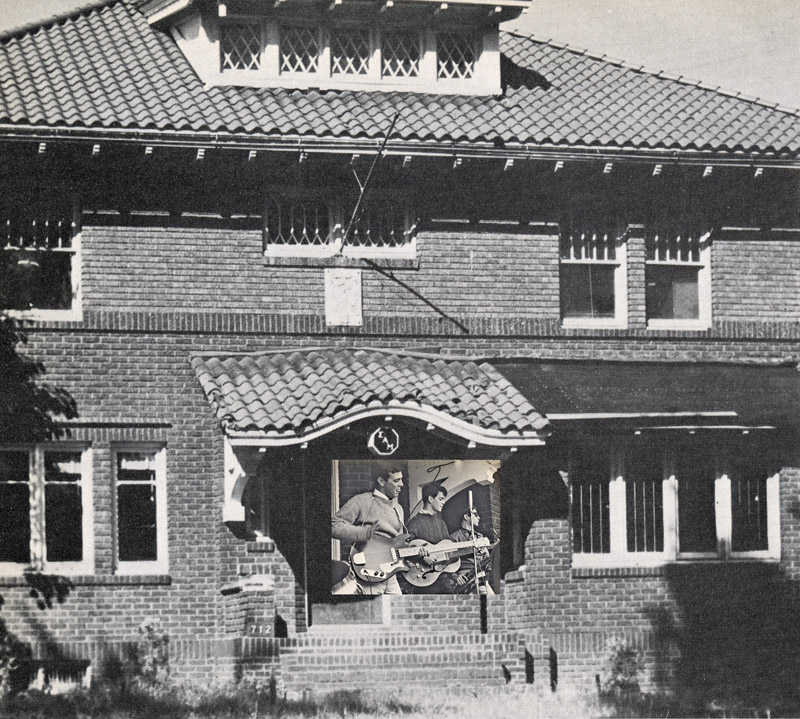
Here's a close-up. (You can click the photo to enlarge it.) 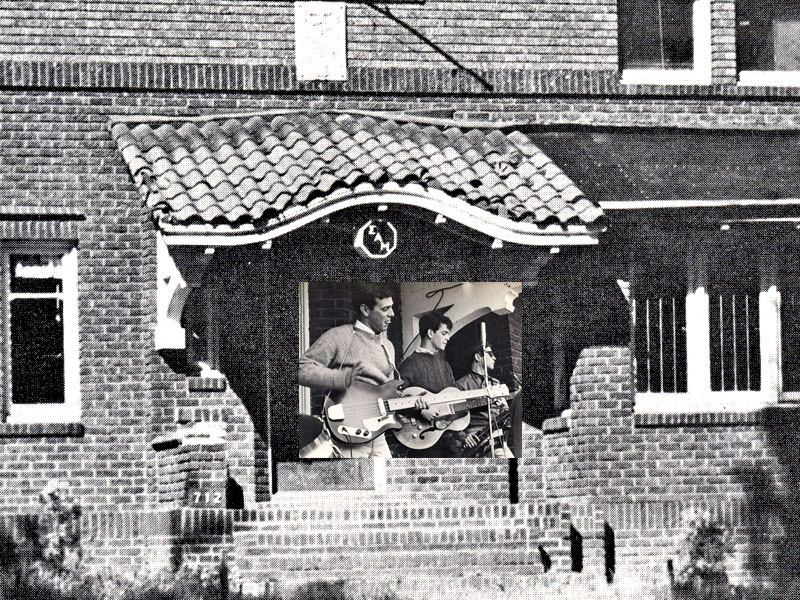
This is an old 1942 map of the University that shows where the Sigma Alpha Mu house was located at 712 Comstock Avenue. It has since moved to elsewhere on campus. (The map is from a plan for the campus by Professor Noreda Rotunno.) 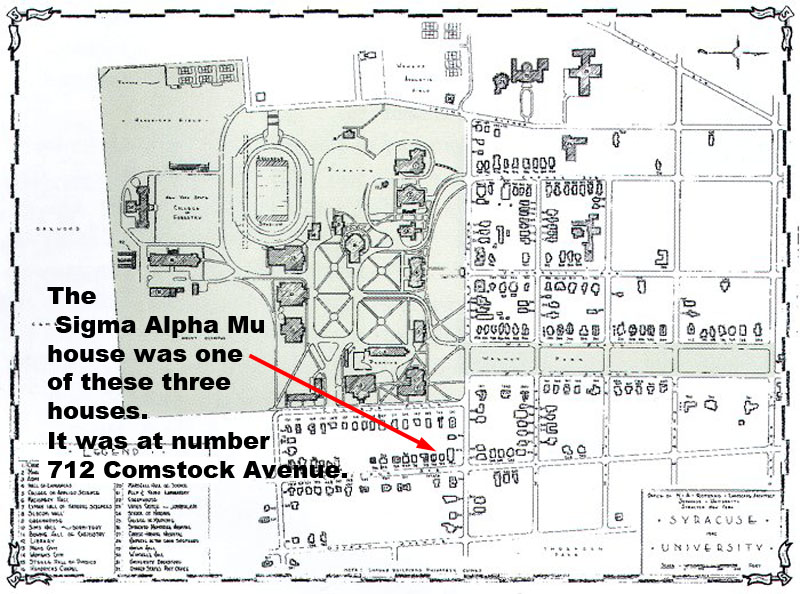
Here's where Syracuse University is located in relation to New York City. 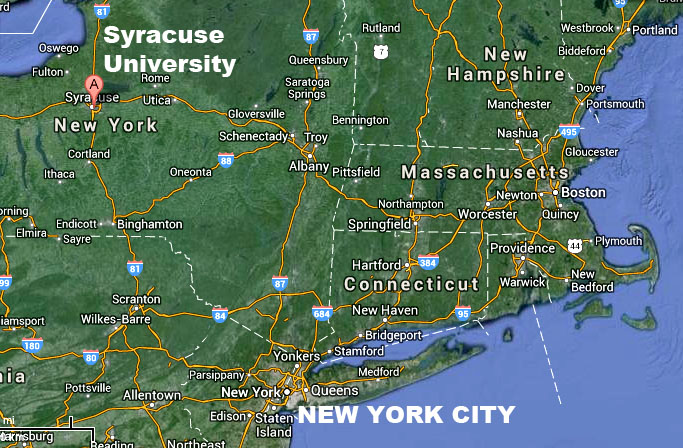
How I found the location: I had been looking for the location of this photo off and on for a while, using Google Street maps to look at buildings around campus. Then, after Lou died, I saw an article in the Syracuse University newspaper called The Daily Orange about Lou by Dylan Segelbaum and Erik Van Rheenan. The article had the photo of Lou and the band with it and the caption said the photo was taken in front of the Sigma Alpha Mu fraternity house. So, I wrote Dylan and asked him if he knew where the Sigma Alpha Mu house was in the early 60's. He wrote back that a Syracuse alum, Don Cronson, whom he had interviewed for the article, knew that it used to be located across from the former Chapel House building which was at 711 Comstock Avenue. So, I found an old map of the University online that showed a row of houses on Comstock where a modern dorm is now (see above). I sent the map to Mary M. O'Brien, the reference archivist at the Syracuse University archives, and asked if she had a picture of the houses that were on that block across from #711. She didn't know of any off-hand, but she said she could look in the yearbooks from while Lou was at Syracuse (1960-1964) for a picture of the Sigma Alpha Mu house. She did -- and she found it! - in the 1962 yearbook. As she wrote to me, "The decorative wooden supports for the front porch roof match the support above Lou Reed's head in the 1963 Onondagan, along with the brick work of the house. I believe we have a match that shows the musicians are on the Sigma Alpha Mu front steps. So, thanks Mary for tracking that down, and thanks, too, to Dylan, Erik, and Don for your help. Mystery solved. A final note: Lou Reed was not an official member of Sigma Alpha Mu, however one of his friends named Allen Hyman was, and Lou hung out at the house a lot, according to Transformer: The Lou Reed Story by Victor Bockris (Simon & Schuster, 1994).
Special Syracuse "bonus photo" sent in by Peter Tiller (Thanks, Peter!): Lou and Garland Jeffries hitting the books at Syracuse in 1962 from a German publication. (photographer unknown at this time) 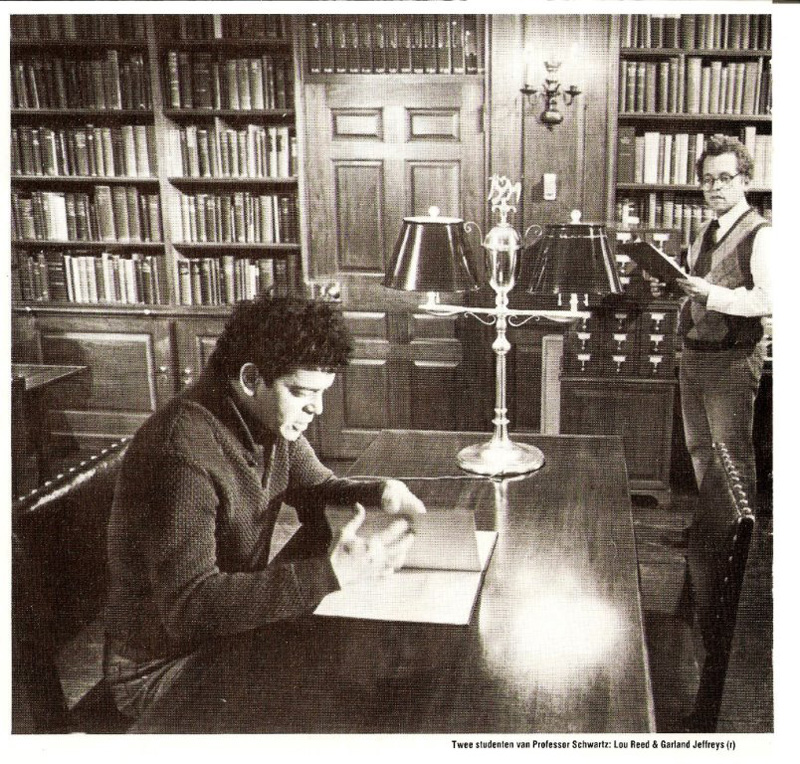
Click Here to see Lou Reed / Velvet Underground PART 2, a POPSPOT-IN-PROGRESS with photos of: 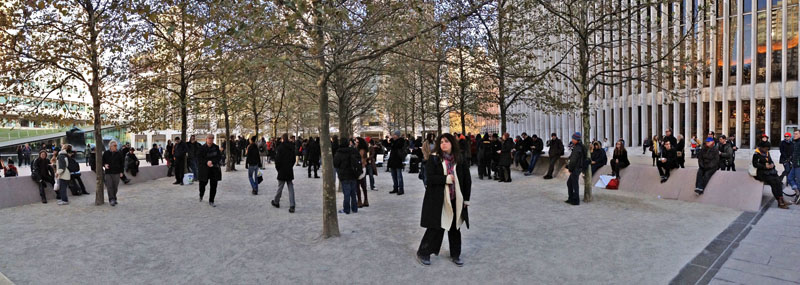
|
||

